Optimizing Energy Consumption in Electric Vehicles: A Systematic and Bibliometric Review of Recent Advances
Abstract
1. Introduction
2. Materials and Methods
Methodological Approach: Bibliometric Analysis
- Phase 1: Literature Search Strategy and Selection Criteria
- Phase 2: Final Selection of Relevant Articles
3. Results and Discussion
3.1. Bibliometric Analysis
3.1.1. Overview of the Analyzed Corpus: Annual Distribution of Publications (2017–2024)
3.1.2. Scientific Mapping of Journals
3.1.3. Analysis of the Most Influential Authors
3.1.4. Author Affiliations
3.1.5. Scientific Mapping of Contributing Countries
3.1.6. Keyword Analysis
- Keyword Frequency: Core Concepts of the Dataset
- Keyword Co-Occurrence Map: Thematic Clusters and Emerging Structures
3.2. Thematic Approach to the Literature
3.2.1. Motor Control and Torque Allocation Strategies for Energy Efficiency Optimization in Single and Multi-Motor Electric Vehicle Architectures
- Hierarchical control schemes: These architectures are typically structured across several layers, with the upper layer defining global objectives (trajectory tracking, autonomy, comfort), while the lower layers handle torque allocation based on motor characteristics and dynamic constraints [80,107,110,113,115,116,117,118,119].
- Predictive control approaches: These methods anticipate short-term driving events (turns, braking, acceleration) to dynamically adjust torque distribution [105]. They may be coupled with databases or predefined operation maps.
- Optimization-based strategies: Techniques such as dynamic programming [81], bio-inspired metaheuristics (e.g., APSO) [108], and online methods such as the Equivalent Consumption Minimization Strategy (ECMS) [106] to improve the economy of the vehicle. They are used to determine the most efficient ways to use energy in electric vehicles along predefined routes, to reduce energy consumption.
- Robust and adaptive controls: In the presence of uncertainties (grip changes, mechanical disturbances, varying loads), approaches like adaptive sliding mode control (DASMC) [112] ensure stable torque regulation even under highly disturbed conditions. In a similar vein, article [111] introduces a robust torque control strategy for dual-motor electric drivetrains using planetary gear transmission, aiming to suppress jerks during mode transitions (e.g., switching between acceleration and regenerative braking). The control system combines PI-based speed feedback with a feedforward torque allocation logic, enhancing ride comfort and system stability despite drivetrain nonlinearities and switching disturbances.
- Intelligent and hybrid control strategies: The integration of artificial intelligence enables systems capable of learning optimal behaviors. Methods such as deep reinforcement learning (AD-DDPG) [109], neural networks trained on driving data [105], or fuzzy systems combined with evolutionary algorithms (like PSO) [114] allow dynamic torque distribution to be tailored to complex and varying driving conditions.
3.2.2. Regenerative Braking Strategies in the Context of Energy Efficiency Optimization for Electric Vehicles
3.2.3. Intelligent Energy Management in Hybrid Energy Storage Systems (HESS) for Enhanced Efficiency and Battery Longevity
3.2.4. Thermal Management as a Core Lever for Enhancing Energy Efficiency in Electric Vehicles
3.2.5. Optimizing Energy Consumption in Cooperative Driving Strategies for Electric Vehicles
- V2V communication reliability and latency: Urban environments often disrupt communication, undermining platoon stability and energy performance. Hybrid solutions or predictive controllers robust to communication loss warrant further exploration.
- Vehicle heterogeneity: Differences in state of charge (SoC), regeneration capacity, or thermal management strategies create imbalances. Adaptive models that account for the internal characteristics of each vehicle are necessary.
- High computational cost: The complexity of real-time predictive controllers remains a barrier to large-scale embedded deployment.
- Limited consideration of lateral behaviors (lane changes, merging): These dynamics, often overlooked, are essential for avoiding energy-wasting slowdowns. Spatio-temporal approaches using Signal Temporal Logic, for example, offer promising avenues.
- Underuse of regenerative braking as an explicit decision variable: Few strategies fully integrate regeneration potential with battery SoC considerations. A truly integrated co-optimization of energy recovery and driving tempo could greatly enhance overall efficiency.
- Aerodynamic vs. comfort trade-off: While driving at close distances within a platoon can significantly reduce aerodynamic drag, it also increases the likelihood of frequent accelerations and braking due to limited reaction time, ultimately leading to higher energy consumption. Future strategies must strike a balance between aerodynamic efficiency and energy comfort by dynamically adjusting inter-vehicle distances according to traffic conditions and vehicle capabilities.
3.2.6. Leveraging Vehicle-to-Grid (V2G) Capabilities for Onboard Energy Optimization
- Dynamic charge adaptation: By considering planned trips, driving profiles, and terrain, the system could optimize the target state of charge (SoC), avoiding unnecessarily high SoC levels. Prolonged operation at high SoC is known to accelerate cell aging, which, over time, reduces the usable driving range [182].
- Controlled partial discharge: In certain scenarios, it may be advantageous to offload non-critical stored energy back to the grid to avoid maintaining a high SoC for extended periods—conditions that induce chemical stress and passive losses, especially at elevated temperatures [183].
- Intelligent thermal preconditioning: Taking advantage of low-tariff or off-peak hours, V2G systems can pre-heat or pre-cool the battery before departure, ensuring operation within its optimal thermal window. This not only improves immediate energy efficiency but also extends the thermal and chemical longevity of battery cells [184].
4. Conclusions
Author Contributions
Funding
Data Availability Statement
Acknowledgments
Conflicts of Interest
References
- Joint Research Centre Data Catalogue—Emissions Database for Global Atmospheric Research…—European Commission. Available online: https://data.jrc.ec.europa.eu/dataset/74f34d14-5819-4954-8b61-b11ce3d4ca48 (accessed on 3 April 2025).
- Fuel Efficiency Technology in European Heavy-Duty Vehicles: Baseline and Potential for the 2020–2030 Timeframe—International Council on Clean Transportation. Available online: https://theicct.org/publication/fuel-efficiency-technology-in-european-heavy-duty-vehicles-baseline-and-potential-for-the-2020-2030-timeframe/ (accessed on 3 April 2025).
- Ghahramani, M.; Pilla, F. Analysis of Carbon Dioxide Emissions from Road Transport Using Taxi Trips. IEEE Access 2021, 9, 98573–98580. [Google Scholar] [CrossRef]
- Zhao, J.; Xi, X.; Na, Q.; Wang, S.; Kadry, S.N.; Kumar, P.M. The Technological Innovation of Hybrid and Plug-in Electric Vehicles for Environment Carbon Pollution Control. Environ. Impact Assess. Rev. 2021, 86, 106506. [Google Scholar] [CrossRef]
- Requia, W.J.; Mohamed, M.; Higgins, C.D.; Arain, A.; Ferguson, M. How Clean Are Electric Vehicles? Evidence-Based Review of the Effects of Electric Mobility on Air Pollutants, Greenhouse Gas Emissions and Human Health. Atmos. Environ. 2018, 185, 64–77. [Google Scholar] [CrossRef]
- Transforming Our World: The 2030 Agenda for Sustainable Development|Department of Economic and Social Affairs. Available online: https://sdgs.un.org/2030agenda (accessed on 4 July 2025).
- Habib, S.; Khan, M.M.; Abbas, F.; Sang, L.; Shahid, M.U.; Tang, H. A Comprehensive Study of Implemented International Standards, Technical Challenges, Impacts and Prospects for Electric Vehicles. IEEE Access 2018, 6, 13866–13890. [Google Scholar] [CrossRef]
- Rainieri, G.; Buizza, C.; Ghilardi, A. The Psychological, Human Factors and Socio-Technical Contribution: A Systematic Review towards Range Anxiety of Battery Electric Vehicles’ Drivers. Transp. Res. Part F Traffic Psychol. Behav. 2023, 99, 52–70. [Google Scholar] [CrossRef]
- Noel, L.; Zarazua de Rubens, G.; Sovacool, B.K.; Kester, J. Fear and Loathing of Electric Vehicles: The Reactionary Rhetoric of Range Anxiety. Energy Res. Soc. Sci. 2019, 48, 96–107. [Google Scholar] [CrossRef]
- Huertas, J.I.; Mogro, A.E.; Jiménez, J.P. Configuration of Electric Vehicles for Specific Applications from a Holistic Perspective. World Electr. Veh. J. 2022, 13, 29. [Google Scholar] [CrossRef]
- Amry, Y.; Elbouchikhi, E.; Le Gall, F.; Ghogho, M.; Hani, E.; Amry, Y.; Elbouchikhi, E.; Le Gall, F.; Ghogho, M.; Hani, S. El Electric Vehicle Traction Drives and Charging Station Power Electronics: Current Status and Challenges. Energies 2022, 15, 6037. [Google Scholar] [CrossRef]
- Wang, Z.; Ching, T.W.; Huang, S.; Wang, H.; Xu, T. Challenges Faced by Electric Vehicle Motors and Their Solutions. IEEE Access 2021, 9, 5228–5249. [Google Scholar] [CrossRef]
- Behi, R.; Behnia, M.; Karimi, D.; Fei, F.; Wang, D. Application of Neural Network Feedforward in Fuzzy PI Controller for Electric Vehicle Thermal Management System: Modeling and Simulation Studies. Energies 2023, 17, 9. [Google Scholar] [CrossRef]
- Lee, S.; Chung, Y.; Jeong, Y.; Kim, M.S. Experimental Study on an Electric Vehicle Heat Pump System with Multi-Level Waste Heat Recovery Using a Vapor Injection Technique at Low Ambient Temperatures. Energy Convers. Manag. 2022, 267, 115935. [Google Scholar] [CrossRef]
- Ma, Y.; Ma, Q.; Ding, H.; Hu, Y.; Chen, H. Multi-Layer NMPC for Battery Thermal Management Optimization Strategy of Connected Electric Vehicle Integrated with Waste Heat Recovery. IEEE Trans. Intell. Transp. Syst. 2024, 25, 6133–6146. [Google Scholar] [CrossRef]
- Ma, Y.; Ma, Q.; Liu, Y.; Gao, J. Adaptive Optimization Control Strategy for Electric Vehicle Battery Thermal Management System Based on Pontryagin’s Minimal Principle. IEEE Trans. Transp. Electrif. 2024, 10, 3855–3869. [Google Scholar] [CrossRef]
- Park, J.; Kim, Y. Supervised-Learning-Based Optimal Thermal Management in an Electric Vehicle. IEEE Access 2020, 8, 1290–1302. [Google Scholar] [CrossRef]
- Khalatbarisoltani, A.; Zhou, H.; Tang, X.; Kandidayeni, M.; Boulon, L.; Hu, X. Energy Management Strategies for Fuel Cell Vehicles: A Comprehensive Review of the Latest Progress in Modeling, Strategies, and Future Prospects. IEEE Trans. Intell. Transp. Syst. 2024, 25, 14–32. [Google Scholar] [CrossRef]
- Satya Veerendra, A.; Rusllim Bin Mohamed, M.; Pedro García arquez, F.M.; Pahang, M.; Arigela Satya Veerendra, C. Energy Management Control Strategies for Energy Storage Systems of Hybrid Electric Vehicle: A Review. Energy Storage 2024, 6, e573. [Google Scholar] [CrossRef]
- Lei, T.; Yang, Z.; Lin, Z.; Zhang, X. State of Art on Energy Management Strategy for Hybrid-Powered Unmanned Aerial Vehicle. Chin. J. Aeronaut. 2019, 32, 1488–1503. [Google Scholar] [CrossRef]
- Williamson, S.S. Energy Management Strategies for Electric and Plug-in Hybrid Electric Vehicles; Springer: New York, NY, USA, 2013. [Google Scholar]
- Xiong, W.; Zhang, Y.; Yin, C. Optimal Energy Management for a Series–Parallel Hybrid Electric Bus. Energy Convers. Manag. 2009, 50, 1730–1738. [Google Scholar] [CrossRef]
- Gómez-Barroso, Á.; Otaola, E.; Onieva, E.; Arteta, B.; Pérez, J.; Prieto, P. Fuzzy Logic Strategy for Traction Control in Parallel Hybrid Vehicles. In Proceedings of the 2023 IEEE 26th International Conference on Intelligent Transportation Systems (ITSC), Bilbao, Spain, 24–28 September 2023; pp. 3686–3691. [Google Scholar] [CrossRef]
- Gao, F.; Gao, X. Hyper-Spherical Search Optimized Fuzzy Logic Control Considering Operating Conditions for Hybrid Tram. IEEE Access 2022, 10, 65925–65935. [Google Scholar] [CrossRef]
- Wei, C.; Wang, X.; Chen, Y.; Wu, H.; Chen, Y. Adaptive Fuzzy Power Management Strategy for Extended-Range Electric Logistics Vehicles Based on Driving Pattern Recognition. Actuators 2023, 12, 410. [Google Scholar] [CrossRef]
- Ghobadpour, A.; Mousazadeh, H.; Kelouwani, S.; Zioui, N.; Kandidayeni, M.; Boulon, L. An Intelligent Energy Management Strategy for an Off-Road Plug-in Hybrid Electric Tractor Based on Farm Operation Recognition. IET Electr. Syst. Transp. 2021, 11, 333–347. [Google Scholar] [CrossRef]
- Montazeri-Gh, M.; Mahmoodi-K, M. Optimized Predictive Energy Management of Plug-in Hybrid Electric Vehicle Based on Traffic Condition. J. Clean. Prod. 2016, 139, 935–948. [Google Scholar] [CrossRef]
- Liu, B.; Li, L.; Wang, X.; Cheng, S. Hybrid Electric Vehicle Downshifting Strategy Based on Stochastic Dynamic Programming during Regenerative Braking Process. IEEE Trans. Veh. Technol. 2018, 67, 4716–4727. [Google Scholar] [CrossRef]
- Vagg, C.; Akehurst, S.; Brace, C.J.; Ash, L. Stochastic Dynamic Programming in the Real-World Control of Hybrid Electric Vehicles. IEEE Trans. Control Syst. Technol. 2016, 24, 853–866. [Google Scholar] [CrossRef]
- Yin, C.; Wang, S.; Yu, C.; Li, J.; Zhang, S. Fuzzy Optimization of Energy Management for Power Split Hybrid Electric Vehicle Based on Particle Swarm Optimization Algorithm. Adv. Mech. Eng. 2019, 11, 1687814019830797. [Google Scholar] [CrossRef]
- Zhang, S.; Xiong, R.; Sun, F. Model Predictive Control for Power Management in a Plug-in Hybrid Electric Vehicle with a Hybrid Energy Storage System. Appl. Energy 2017, 185, 1654–1662. [Google Scholar] [CrossRef]
- Huang, Y.; Wang, H.; Khajepour, A.; He, H.; Ji, J. Model Predictive Control Power Management Strategies for HEVs: A Review. J. Power Sources 2017, 341, 91–106. [Google Scholar] [CrossRef]
- Zhang, F.; Liu, H.; Hu, Y.; Xi, J. A Supervisory Control Algorithm of Hybrid Electric Vehicle Based on Adaptive Equivalent Consumption Minimization Strategy with Fuzzy PI. Energies 2016, 9, 919. [Google Scholar] [CrossRef]
- Poursamad, A.; Montazeri, M. Design of Genetic-Fuzzy Control Strategy for Parallel Hybrid Electric Vehicles. Control Eng. Pract. 2008, 16, 861–873. [Google Scholar] [CrossRef]
- Dawei, M.; Yu, Z.; Meilan, Z.; Risha, N. Intelligent Fuzzy Energy Management Research for a Uniaxial Parallel Hybrid Electric Vehicle. Comput. Electr. Eng. 2017, 58, 447–464. [Google Scholar] [CrossRef]
- Lü, X.; Wu, Y.; Lian, J.; Zhang, Y.; Chen, C.; Wang, P.; Meng, L. Energy Management of Hybrid Electric Vehicles: A Review of Energy Optimization of Fuel Cell Hybrid Power System Based on Genetic Algorithm. Energy Convers. Manag. 2020, 205, 112474. [Google Scholar] [CrossRef]
- Uebel, S.; Murgovski, N.; Bäker, B.; Sjöberg, J. A Two-Level MPC for Energy Management Including Velocity Control of Hybrid Electric Vehicles. IEEE Trans. Veh. Technol. 2019, 68, 5494–5505. [Google Scholar] [CrossRef]
- Borhan, H.; Vahidi, A.; Phillips, A.M.; Kuang, M.L.; Kolmanovsky, I.V.; Di Cairano, S. MPC-Based Energy Management of a Power-Split Hybrid Electric Vehicle. IEEE Trans. Control Syst. Technol. 2012, 20, 593–603. [Google Scholar] [CrossRef]
- Bonab, S.A.; Emadi, A. MPC-Based Energy Management Strategy for an Autonomous Hybrid Electric Vehicle. IEEE Open J. Ind. Appl. 2020, 1, 171–180. [Google Scholar] [CrossRef]
- Leduc, B.; Tona, P.; Payri, F.; Luján, J.M.; Guardiola, C.; Pla, B.; Christen, U.; Busch, R.; Cavina, N.; Corti, E.; et al. Design and Evaluation of Energy Management Using Map-Based ECMS for the PHEV Benchmark. Oil Gas Sci. Technol.-Rev. d’IFP Energ. Nouv. 2015, 70, 195–211. [Google Scholar] [CrossRef]
- Mittal, V.; Shah, R. Energy Management Strategies for Hybrid Electric Vehicles: A Technology Roadmap. World Electr. Veh. J. 2024, 15, 424. [Google Scholar] [CrossRef]
- Song, C.; Kim, K.; Sung, D.; Kim, K.; Yang, H.; Lee, H.; Cho, G.Y.; Cha, S.W. A Review of Optimal Energy Management Strategies Using Machine Learning Techniques for Hybrid Electric Vehicles. Int. J. Automot. Technol. 2021, 22, 1437–1452. [Google Scholar] [CrossRef]
- Murphey, Y.L.; Park, J.; Chen, Z.; Kuang, M.L.; Masrur, M.A.; Phillips, A.M. Intelligent Hybrid Vehicle Power Control Part I: Machine Learning of Optimal Vehicle Power. IEEE Trans. Veh. Technol. 2012, 61, 3519–3530. [Google Scholar] [CrossRef]
- Xu, B.; Shi, J.; Li, S.; Li, H. A Study of Vehicle Driving Condition Recognition Using Supervised Learning Methods. IEEE Trans. Transp. Electrif. 2022, 8, 1665–1673. [Google Scholar] [CrossRef]
- Divakarla, K.P.; Wirasingha, S.G.; Emadi, A.; Razavi, S. Artificial Neural Network Based Adaptive Control for Plug-in Hybrid Electric Vehicles. Int. J. Electr. Hybrid Veh. 2019, 11, 127–151. [Google Scholar] [CrossRef]
- Wang, D.; Yang, J.; Yang, Q.; Wu, D.; Jin, H. Estimation and Control of Hybrid Electric Vehicle Using Artificial Neural Networks. In Proceedings of the 2007 2nd IEEE Conference on Industrial Electronics and Applications, Harbin, China, 23–25 May 2007; pp. 35–40. [Google Scholar] [CrossRef]
- Upadhyaya, A.; Mahanta, C. Improving Velocity Prediction in Electric Vehicles Using Hybrid Artificial Neural Network (ANN). In Proceedings of the 2022 IEEE 10th Conference on Systems, Process & Control (ICSPC), Malacca, Malaysia, 17 December 2022; pp. 94–99. [Google Scholar] [CrossRef]
- Yin, Y.; Ran, Y.; Zhang, L.; Pan, X.; Luo, Y. An Energy Management Strategy for a Super-Mild Hybrid Electric Vehicle Based on a Known Model of Reinforcement Learning. J. Control. Sci. Eng. 2019, 2019, 9259712. [Google Scholar] [CrossRef]
- Kumar, A.; Kukker, A. Reinforcement Learning-Based Intelligent Energy Management System for Electric Vehicle. Intell. Control Mod. Transp. Syst. 2023, 153–170. [Google Scholar] [CrossRef]
- Zhang, Y.; Wang, Z.; Tian, Y.; Wang, Z.; Kang, M.; Xie, F.; Wen, G. Pre-Optimization-Assisted Deep Reinforcement Learning-Based Energy Management Strategy for a Series–Parallel Hybrid Electric Truck. Energy 2024, 302, 131628. [Google Scholar] [CrossRef]
- Han, R.; He, H.; Wang, Y.; Wang, Y. Reinforcement Learning Based Energy Management Strategy for Fuel Cell Hybrid Electric Vehicles. Chin. J. Mech. Eng. 2025, 38, 66. [Google Scholar] [CrossRef]
- Kermansaravi, A.; Refaat, S.S.; Trabelsi, M.; Vahedi, H. AI-Based Energy Management Strategies for Electric Vehicles: Challenges and Future Directions. Energy Rep. 2025, 13, 5535–5550. [Google Scholar] [CrossRef]
- van Raan, A. Measuring Science: Basic Principles and Application of Advanced Bibliometrics. In Springer Handbooks; Springer: Berlin/Heidelberg, Germany, 2019; pp. 237–280. [Google Scholar] [CrossRef]
- (PDF) Bibliometrics as a Research Field: A Course on Theory and Application of Bibliometric Indicators. Available online: https://www.researchgate.net/publication/242406991_Bibliometrics_as_a_research_field_A_course_on_theory_and_application_of_bibliometric_indicators (accessed on 15 September 2025).
- Diodato, V. Dictionary of Bibliometrics; Routledge and Taylor & Francis Group: Oxfordshire, UK, 2013; pp. 1–179. [Google Scholar] [CrossRef]
- Passas, I. Bibliometric Analysis: The Main Steps. Encyclopedia 2024, 4, 1014–1025. [Google Scholar] [CrossRef]
- Barbosa, W.; Prado, T.; Batista, C.; Câmara, J.C.; Cerqueira, R.; Coelho, R.; Guarieiro, L. Electric Vehicles: Bibliometric Analysis of the Current State of the Art and Perspectives. Energies 2022, 15, 395. [Google Scholar] [CrossRef]
- Ullah, I.; Safdar, M.; Zheng, J.; Severino, A.; Jamal, A. Employing Bibliometric Analysis to Identify the Current State of the Art and Future Prospects of Electric Vehicles. Energies 2023, 16, 2344. [Google Scholar] [CrossRef]
- Veza, I.; Syaifuddin, M.; Idris, M.; Herawan, S.G.; Yusuf, A.A.; Fattah, I.M.R. Electric Vehicle (EV) Review: Bibliometric Analysis of Electric Vehicle Trend, Policy, Lithium-Ion Battery, Battery Management, Charging Infrastructure, Smart Charging, and Electric Vehicle-to-Everything (V2X). Energies 2024, 17, 3786. [Google Scholar] [CrossRef]
- Miah, M.S.; Hossain Lipu, M.S.; Meraj, S.T.; Hasan, K.; Ansari, S.; Jamal, T.; Masrur, H.; Elavarasan, R.M.; Hussain, A. Optimized Energy Management Schemes for Electric Vehicle Applications: A Bibliometric Analysis towards Future Trends. Sustainability 2021, 13, 12800. [Google Scholar] [CrossRef]
- Bhat, F.A.; Verma, A. A Bibliometric Analysis and Review of Adoption Behaviour of Electric Vehicles. Transp. Dev. Econ. 2022, 9, 5. [Google Scholar] [CrossRef]
- Bibliometric Analysis for Beginners (UUM Press)—Aidi Ahmi—Google Livres. Available online: https://books.google.co.ma/books?hl=fr&lr=&id=CwsCEQAAQBAJ&oi=fnd&pg=PR14&dq=what+is+bibliometric+analysis+book&ots=cDr-5RTZ5R&sig=JhRe4UDsIaJFbw-S39HKOVcTLjc&redir_esc=y#v=onepage&q&f=true (accessed on 9 April 2025).
- Statistical Bibliography or Bibliometrics|CiNii Research. Available online: https://cir.nii.ac.jp/crid/1570009750342049664 (accessed on 9 April 2025).
- Rousseau, R. Library Science: Forgotten Founder of Bibliometrics. Nature 2014, 510, 218. [Google Scholar] [CrossRef]
- Broadus, R.N. Toward a Definition of “Bibliometrics”. Scientometrics 1987, 12, 373–379. [Google Scholar] [CrossRef]
- Donthu, N.; Kumar, S.; Mukherjee, D.; Pandey, N.; Lim, W.M. How to Conduct a Bibliometric Analysis: An Overview and Guidelines. J. Bus. Res. 2021, 133, 285–296. [Google Scholar] [CrossRef]
- Szomszor, M.; Adams, J.; Fry, R.; Gebert, C.; Pendlebury, D.A.; Potter, R.W.K.; Rogers, G. Interpreting Bibliometric Data. Front. Res. Metrics Anal. 2020, 5, 628703. [Google Scholar] [CrossRef] [PubMed]
- Tarazi, A. Comparative Analysis of the Bibliographic Data Sources Using PubMed, Scopus, Web of Science, and Lens. High Yield Med. Rev. 2024, 2, 1–10. [Google Scholar] [CrossRef]
- Al-Khoury, A.; Hussein, S.A.; Abdulwhab, M.; Aljuboori, Z.M.; Haddad, H.; Ali, M.A.; Abed, I.A.; Flayyih, H.H. Intellectual Capital History and Trends: A Bibliometric Analysis Using Scopus Database. Sustainability 2022, 14, 11615. [Google Scholar] [CrossRef]
- Raboaca, M.S.; Bizon, N.; Grosu, O.V. Optimal Energy Management Strategies for the Electric Vehicles Compiling Bibliometric Maps. Int. J. Energy Res. 2021, 45, 10129–10172. [Google Scholar] [CrossRef]
- Zhang, P.; Yan, F.; Du, C. A Comprehensive Analysis of Energy Management Strategies for Hybrid Electric Vehicles Based on Bibliometrics. Renew. Sustain. Energy Rev. 2015, 48, 88–104. [Google Scholar] [CrossRef]
- Öztürk, O.; Kocaman, R.; Kanbach, D.K. How to Design Bibliometric Research: An Overview and a Framework Proposal. Rev. Manag. Sci. 2024, 18, 3333–3361. [Google Scholar] [CrossRef]
- Linnenluecke, M.K.; Marrone, M.; Singh, A.K. Conducting Systematic Literature Reviews and Bibliometric Analyses. Aust. J. Manag. 2020, 45, 175–194. [Google Scholar] [CrossRef]
- Page, M.J.; McKenzie, J.E.; Bossuyt, P.M.; Boutron, I.; Hoffmann, T.C.; Mulrow, C.D.; Shamseer, L.; Tetzlaff, J.M.; Akl, E.A.; Brennan, S.E.; et al. The PRISMA 2020 Statement: An Updated Guideline for Reporting Systematic Reviews. BMJ 2021, 372. [Google Scholar] [CrossRef] [PubMed]
- Gutiérrez-Salcedo, M.; Martínez, M.Á.; Moral-Munoz, J.A.; Herrera-Viedma, E.; Cobo, M.J. Some Bibliometric Procedures for Analyzing and Evaluating Research Fields. Appl. Intell. 2018, 48, 1275–1287. [Google Scholar] [CrossRef]
- Huang, J.-H.; Duan, X.-Y.; He, F.-F.; Wang, G.-J.; Hu, X.-Y. A Historical Review and Bibliometric Analysis of Research on Weak Measurement Research over the Past Decades Based on Biblioshiny. arXiv 2021, arXiv:2108.11375. [Google Scholar] [CrossRef]
- van Eck, N.J.; Waltman, L. Software Survey: VOSviewer, a Computer Program for Bibliometric Mapping. Scientometrics 2009, 84, 523–538. [Google Scholar] [CrossRef] [PubMed]
- Moral-Muñoz, J.A.; Herrera-Viedma, E.; Santisteban-Espejo, A.; Cobo, M.J. Software Tools for Conducting Bibliometric Analysis in Science: An up-to-Date Review. Prof. la Inf. 2020, 29, 1699–2407. [Google Scholar] [CrossRef]
- Colina, A.; Mina, M.E. Bibliometric Software: The Most Commonly Used in Research. Available online: https://www.academia.edu/128585674/Bibliometric_Software_The_Most_Commonly_Used_in_Research (accessed on 11 August 2025).
- Li, Y.; Zhang, J.; Lv, C.; Yuan, Y. Coordinated Control of the Steering System and the Distributed Motors for Comprehensive Optimization of the Dynamics Performance and the Energy Consumption of an Electric Vehicle. Proc. Inst. Mech. Eng. Part D J. Automob. Eng. 2016, 231, 1605–1626. [Google Scholar] [CrossRef]
- Wang, W.; Shi, J.; Zhang, Z.; Lin, C. Optimization of a Dual-Motor Coupled Powertrain Energy Management Strategy for a Battery Electric Bus. Energy Procedia 2018, 145, 20–25. [Google Scholar] [CrossRef]
- Chavda, J.K.; Shah, V.A. Energy Management of an Electric Vehicle by Hybrid Energy Storage System with Novel Control Strategy. J. Adv. Res. Dyn. Control Syst. 2019, 11, 1923–1943. [Google Scholar]
- Sadeq, T.; Wai, C.K.; Morris, E.; Tarboosh, Q.A.; Aydogdu, O. Optimal Control Strategy to Maximize the Performance of Hybrid Energy Storage System for Electric Vehicle Considering Topography Information. IEEE Access 2020, 8, 216994–217007. [Google Scholar] [CrossRef]
- Wang, W.; Li, Y.; Shi, M.; Song, Y. Optimization and Control of Battery-Flywheel Compound Energy Storage System during an Electric Vehicle Braking. Energy 2021, 226, 120404. [Google Scholar] [CrossRef]
- Pan, C.; Huang, A.; Wang, J.; Chen, L.; Liang, J.; Zhou, W.; Wang, L.; Yang, J. Energy-Optimal Adaptive Cruise Control Strategy for Electric Vehicles Based on Model Predictive Control. Energy 2022, 241, 122793. [Google Scholar] [CrossRef]
- Pan, C.F.; Li, Y.; Huang, A.B.; Wang, J.; Liang, J. Energy-Optimized Adaptive Cruise Control Strategy Design at Intersection for Electric Vehicles Based on Speed Planning. Sci. China Technol. Sci. 2023, 66, 3504–3521. [Google Scholar] [CrossRef]
- Nambisan, P.; Khanra, M. Optimal Power-Split of Hybrid Energy Storage System Using Pontryagin’s Minimum Principle and Deep Reinforcement Learning Approach for Electric Vehicle Application. Eng. Appl. Artif. Intell. 2024, 135, 108769. [Google Scholar] [CrossRef]
- China Electric Vehicles Market Size & Industry Report 2030. Available online: https://www.mordorintelligence.com/industry-reports/china-electric-vehicles-ev-market-outlook?utm_source=chatgpt.com (accessed on 17 September 2025).
- Zhao, Q.; Li, Z.; Zhang, C. The Impact of R&D and Non-R&D Subsidies on Technological Innovation in Chinese Electric Vehicle Enterprises. World Electr. Veh. J. 2024, 15, 304. [Google Scholar] [CrossRef]
- How Innovative Is China in the Electric Vehicle and Battery Industries?|ITIF. Available online: https://itif.org/publications/2024/07/29/how-innovative-is-china-in-the-electric-vehicle-and-battery-industries/?utm_source=chatgpt.com (accessed on 17 September 2025).
- Inside China’s Electric Vehicle Revolution: A Closer Look. Available online: https://alltechmagazine.com/inside-chinas-electric-vehicle-revolution/?utm_source=chatgpt.com (accessed on 17 September 2025).
- Zhao, S.; Kim, S.Y.; Wu, H.; Yan, J.; Xiong, J. Closing the Gap: The Chinese Electric Vehicle Industry Owns the Road. J. Bus. Strategy 2020, 41, 3–14. [Google Scholar] [CrossRef]
- Zhou, X.; Sun, C.; Sun, F.; Zhang, C. Commuting-Pattern-Oriented Optimal Sizing of Electric Vehicle Powertrain Based on Stochastic Optimization. J. Power Sources 2022, 545, 231786. [Google Scholar] [CrossRef]
- Battery-Supercapacitor Energy, F.; Astaneh, M.; Andric, J.; Lemian, D.; Bode, F. Battery-Supercapacitor Energy Storage Systems for Electrical Vehicles: A Review. Energies 2022, 15, 5683. [Google Scholar] [CrossRef]
- Hasan, M.K.; Mahmud, M.; Ahasan Habib, A.K.M.; Motakabber, S.M.A.; Islam, S. Review of Electric Vehicle Energy Storage and Management System: Standards, Issues, and Challenges. J. Energy Storage 2021, 41, 102940. [Google Scholar] [CrossRef]
- Dan, D.; Zhao, Y.; Wei, M.; Wang, X. Review of Thermal Management Technology for Electric Vehicles. Energies 2023, 16, 4693. [Google Scholar] [CrossRef]
- Sultan, V.; Aryal, A.; Chang, H.; Kral, J. Integration of EVs into the Smart Grid: A Systematic Literature Review. Energy Inform. 2022, 5, 65. [Google Scholar] [CrossRef]
- Donkers, A.; Yang, D.; Viktorović, M. Influence of Driving Style, Infrastructure, Weather and Traffic on Electric Vehicle Performance. Transp. Res. Part D Transp. Environ. 2020, 88, 102569. [Google Scholar] [CrossRef]
- He, Z.; Shi, Q.; Wei, Y.; Zheng, J.; Gao, B.; He, L. A Torque Demand Model Predictive Control Approach for Driving Energy Optimization of Battery Electric Vehicle. IEEE Trans. Veh. Technol. 2021, 70, 3232–3242. [Google Scholar] [CrossRef]
- Murali, A.; Wahab, R.S.; Gade, C.S.R.; Annamalai, C.; Subramaniam, U. Assessing Finite Control Set Model Predictive Speed Controlled Pmsm Performance for Deployment in Electric Vehicles. World Electr. Veh. J. 2021, 12, 41. [Google Scholar] [CrossRef]
- Hu, J.; Yang, Y.; Jia, M.; Guan, Y.; Peng, T. A Novel Energy Optimization Control Strategy for Electric Drive System Based on Current Angle. Appl. Sci. 2020, 10, 3778. [Google Scholar] [CrossRef]
- Bouguenna, I.F.; Azaiz, A.; Tahour, A.; Larbaoui, A. Robust Neuro-Fuzzy Sliding Mode Control with Extended State Observer for an Electric Drive System. Energy 2019, 169, 1054–1063. [Google Scholar] [CrossRef]
- Nepomnyashchiy, O.; Kazakov, F.; Ostroverkhov, D.; Tarasov, A.; Sirotinina, N. A Neural Regulator for Efficient Control of Electric Vehicle Motors. EAI Endorsed Trans. Energy Web 2020, 7, e3. [Google Scholar] [CrossRef]
- Saiteja, P.; Ashok, B.; Mason, B.; Krishna, S. Development of Efficient Energy Management Strategy to Mitigate Speed and Torque Ripples in SR Motor Through Adaptive Supervisory Self-Learning Technique for Electric Vehicles. IEEE Access 2023, 11, 96460–96484. [Google Scholar] [CrossRef]
- Zhang, Z.; Ding, H.; Guo, K.; Zhang, N. A Hierarchical Control Strategy for FWID-EVs Based on Multi-Agent with Consideration of Safety and Economy. Energies 2022, 15, 9112. [Google Scholar] [CrossRef]
- Dou, H.; Zhang, Y.; Fan, L. Design of Optimized Energy Management Strategy for All-Wheel-Drive Electric Vehicles. Appl. Sci. 2021, 11, 8218. [Google Scholar] [CrossRef]
- Wang, J.; Li, J. Hierarchical Coordinated Control Method of In-Wheel Motor Drive Electric Vehicle Based on Energy Optimization. World Electr. Veh. J. 2019, 10, 15. [Google Scholar] [CrossRef]
- He, H.; Han, M.; Liu, W.; Cao, J.; Shi, M.; Zhou, N. MPC-Based Longitudinal Control Strategy Considering Energy Consumption for a Dual-Motor Electric Vehicle. Energy 2022, 253, 124004. [Google Scholar] [CrossRef]
- Zhao, Y.; Deng, H.; Li, Y.; Xu, H. Coordinated Control of Stability and Economy Based on Torque Distribution of Distributed Drive Electric Vehicle. Proc. Inst. Mech. Eng. Part D J. Automob. Eng. 2019, 234, 1792–1806. [Google Scholar] [CrossRef]
- Xiong, H.; Tan, Z.; Zhang, R.; He, S. A New Dual Axle Drive Optimization Control Strategy for Electric Vehicles Using Vehicle-to-Infrastructure Communications. IEEE Trans. Ind. Inform. 2020, 16, 2574–2582. [Google Scholar] [CrossRef]
- Najjari, B.; Mirzaei, M.; Tahouni, A. Constrained Stability Control with Optimal Power Management Strategy for In-Wheel Electric Vehicles. Proc. Inst. Mech. Eng. Part K J. Multi-Body Dyn. 2019, 233, 1014–1032. [Google Scholar] [CrossRef]
- Wu, J.; Wang, B.; Hong, X. Driving Torque Control of Dual-Motor Powertrain for Electric Vehicles. Actuators 2022, 11, 320. [Google Scholar] [CrossRef]
- Zhang, C.; Zhang, S.; Han, G.; Liu, H. Power Management Comparison for a Dual-Motor-Propulsion System Used in a Battery Electric Bus. IEEE Trans. Ind. Electron. 2017, 64, 3873–3882. [Google Scholar] [CrossRef]
- Liang, J.; Xu, X.; Dong, P.; Feng, T.; Guo, W.; Wang, S. Energy Management Strategy of a Novel Electric Dual-Motor Transmission for Heavy Commercial Vehicles Based on APSO Algorithm. Sustainability 2022, 14, 1163. [Google Scholar] [CrossRef]
- Guo, Z.; Chu, L.; Hou, Z.; Wang, Y.; Hu, J.; Sun, W. A Dual Distribution Control Method for Multi-Power Components Energy Output of 4WD Electric Vehicles. Sensors 2022, 22, 9597. [Google Scholar] [CrossRef] [PubMed]
- Zhang, H.; Zhou, C.; Wang, C.; Zhao, W. An Energy Efficient Control Strategy for Electric Vehicle Driven by In-Wheel-Motors Based on Discrete Adaptive Sliding Mode Control. Chin. J. Mech. Eng. 2023, 36, 58. [Google Scholar] [CrossRef]
- Wu, J.; Zhang, N. Driving Mode Shift Control for Planetary Gear Based Dual Motor Powertrain in Electric Vehicles. Mech. Mach. Theory 2021, 158, 104217. [Google Scholar] [CrossRef]
- Ruan, J.; Wu, C.; Cui, H.; Li, W.; Sauer, D.U. Delayed Deep Deterministic Policy Gradient-Based Energy Management Strategy for Overall Energy Consumption Optimization of Dual Motor Electrified Powertrain. IEEE Trans. Veh. Technol. 2023, 72, 11415–11427. [Google Scholar] [CrossRef]
- Wang, J.; Gao, S.; Wang, K.; Wang, Y.; Wang, Q. Wheel Torque Distribution Optimization of Four-Wheel Independent-Drive Electric Vehicle for Energy Efficient Driving. Control Eng. Pract. 2021, 110, 104779. [Google Scholar] [CrossRef]
- Bautista-Montesano, R.; Galluzzi, R.; Mo, Z.; Fu, Y.; Bustamante-Bello, R.; Di, X. Longitudinal Control Strategy for Connected Electric Vehicle with Regenerative Braking in Eco-Approach and Departure. Appl. Sci. 2023, 13, 5089. [Google Scholar] [CrossRef]
- Luo, D.; Yang, W.; Wang, Y.; Han, Y.; Liu, Q.; Yang, Y. Investigation of Regenerative Braking for the Electric Mining Truck Based on Fuzzy Control. Int. J. Veh. Perform. 2024, 10, 73–95. [Google Scholar] [CrossRef]
- Mei, P.; Karimi, H.R.; Yang, S.; Xu, B.; Huang, C. An Adaptive Fuzzy Sliding-Mode Control for Regenerative Braking System of Electric Vehicles. Int. J. Adapt. Control Signal Process. 2022, 36, 391–410. [Google Scholar] [CrossRef]
- Weiwei, Y.; Denghao, L.; Wenming, Z.; Weiwei, Y.; Denghao, L.; Wenming, Z. Regenerative Braking Strategy Based on Deep Reinforcement Learning for an Electric Mining Truck. Chin. J. Eng. 2024, 46, 503–513. [Google Scholar] [CrossRef]
- Yu, Z.; Feng, H.; Meng, Y.; Xu, E.; Wu, Y. Braking Energy Management Strategy for Electric Vehicles Based on Working Condition Prediction. AIP Adv. 2022, 12, 015220. [Google Scholar] [CrossRef]
- Chengqun, Q.; Wan, X.; Wang, N.; Cao, S.; Ji, X.; Wu, K.; Hu, Y.; Meng, M. A Novel Regenerative Braking Energy Recuperation System for Electric Vehicles Based on Driving Style. Energy 2023, 283, 129055. [Google Scholar] [CrossRef]
- Xu, W.; Chen, H.; Zhao, H.Y. Braking Energy Optimization Control for Four In-Wheel Motors Electric Vehicles Considering Battery Life [考虑电池寿命的四轮轮毂电动汽车制动能量优化控制]. Kongzhi Lilun Yu Yingyong/Control Theory Appl. 2019, 36, 1942–1951. [Google Scholar] [CrossRef]
- Wang, B.; Xu, J.; Xu, D.; Yan, Z. Implementation of an Estimator-Based Adaptive Sliding Mode Control Strategy for a Boost Converter Based Battery/Supercapacitor Hybrid Energy Storage System in Electric Vehicles. Energy Convers. Manag. 2017, 151, 562–572. [Google Scholar] [CrossRef]
- Song, Z.; Hou, J.; Hofmann, H.; Li, J.; Ouyang, M. Sliding-Mode and Lyapunov Function-Based Control for Battery/Supercapacitor Hybrid Energy Storage System Used in Electric Vehicles. Energy 2017, 122, 601–612. [Google Scholar] [CrossRef]
- Bai, Z.; Yan, Z.; Wu, X.; Xu, J.; Cao, B. H∞ Control for Battery/Supercapacitor Hybrid Energy Storage System Used in Electric Vehicles. Int. J. Automot. Technol. 2019, 20, 1287–1296. [Google Scholar] [CrossRef]
- Yodwong, B.; Thounthong, P.; Guilbert, D.; Bizon, N. Differential Flatness-Based Cascade Energy/Current Control of Battery/Supercapacitor Hybrid Source for Modern e–Vehicle Applications. Mathematics 2020, 8, 704. [Google Scholar] [CrossRef]
- Mahadik, Y.; Vadirajacharya, K. Battery Life Enhancement in a Hybrid Electrical Energy Storage System Using a Multi-Source Inverter. World Electr. Veh. J. 2019, 10, 17. [Google Scholar] [CrossRef]
- Zhang, X.Z.; Lu, Z.Y.; Tan, C.Z.; Zheng, L. Global Sliding Mode Control of Vehicle-Mounted Hybrid Energy Storage System Based on Exponential Reaching Law. Kongzhi yu Juece/Control Decis. 2021, 36, 885–892. [Google Scholar] [CrossRef]
- Saied, B.; Nasri, A.; Hamzat, E.; Chergui, H.; Korhan, K. Pioneering Battery-Supercapacitor Hybrid Energy Management for E-Scooters for Sustainable Urban Transportation. Prz. Elektrotechniczny 2024, 2024, 113–117. [Google Scholar] [CrossRef]
- Lu, Z.; Zhang, X. Composite Non-Linear Control of Hybrid Energy-Storage System in Electric Vehicle. Energies 2022, 15, 1567. [Google Scholar] [CrossRef]
- Ramineni, P.; Pandian, A.; Kumar, M.K.; Sundaram, K.M. Improved Operation of Li-Ion Li-Ion Battery with Supercapacitor Realized to Solar-Electric Vehicle. Energy Rep. 2022, 8, 256–264. [Google Scholar] [CrossRef]
- Liu, C.; Sun, K.; Li, R. Adaptive Power Allocation Strategy for Hybrid Energy Storage System Based on Hilbert-Huang Transform. In Proceedings of the 2020 12th IEEE PES Asia-Pacific Power and Energy Engineering Conference (APPEEC), Nanjing, China, 20–23 September 2020. [Google Scholar] [CrossRef]
- Zhang, X.; Lu, Z.; Lu, M. Vehicle Speed Optimized Fuzzy Energy Management for Hybrid Energy Storage System in Electric Vehicles. Complexity 2020, 2020, 2073901. [Google Scholar] [CrossRef]
- Zhou, M.; Wang, J.; Chen, Q. Research on Vehicle Controller and Control Strategy for Pure Electric Vehicle with Composite Power. Int. J. Electr. Hybrid Veh. 2019, 11, 170–193. [Google Scholar] [CrossRef]
- (PDF) Multi-Fuzzy Control Based Energy Management Strategy of Battery/Super-Capacitor Hybrid Energy System of Electric Vehicles. Available online: https://www.researchgate.net/publication/337948419_Multi-Fuzzy_Control_Based_Energy_Management_Strategy_of_Battery_Super-capacitor_Hybrid_Energy_System_of_Electric_Vehicles (accessed on 8 May 2025).
- Lu, H.; Sun, B.; Hu, Z. Research on Energy Management Strategy of Battery-Flywheel Hybrid Energy Storage Electric Vehicle. IEEE Trans. Power Electron. 2022, 40, 9944–9956. [Google Scholar]
- Zhang, Q.; Cheng, X.; Liao, S. Implementation of a Predictive Energy Management Strategy for Battery and Supercapacitor Hybrid Energy Storage Systems of Pure Electric Vehicles. J. Intell. Fuzzy Syst. 2021, 41, 2539–2549. [Google Scholar] [CrossRef]
- Wang, L.; Wang, Y.; Liu, C.; Yang, D.; Chen, Z. A Power Distribution Strategy for Hybrid Energy Storage System Using Adaptive Model Predictive Control. IEEE Trans. Power Electron. 2020, 35, 5897–5906. [Google Scholar] [CrossRef]
- Zhou, Y.; Huang, Z.; Liao, H.; Li, H.; Jiao, Y.; Peng, J. A Predictive Set-Point Modulation Energy Management Strategy for Hybrid Energy Storage Systems. IEEE Trans. Ind. Appl. 2019, 55, 6266–6277. [Google Scholar] [CrossRef]
- Katnapally, A.; Manthati, U.B.; Chirayarukil Raveendran, A.; Punna, S. A Predictive Power Management Scheme for Hybrid Energy Storage System in Electric Vehicle. Int. J. Circuit Theory Appl. 2021, 49, 3864–3878. [Google Scholar] [CrossRef]
- Larijani, M.R.; Kia, S.H.; Zolghadri, M.; Hajjaji, A.E.; Taghavipour, A. Linear Parameter-Varying Model Predictive Control for Intelligent Energy Management in Battery/Supercapacitor Electric Vehicles. IEEE Access 2024, 12, 51026–51040. [Google Scholar] [CrossRef]
- Liu, C.; Wang, Y.; Wang, L.; Chen, Z. Load-Adaptive Real-Time Energy Management Strategy for Battery/Ultracapacitor Hybrid Energy Storage System Using Dynamic Programming Optimization. J. Power Sources 2019, 438, 227024. [Google Scholar] [CrossRef]
- Nguyễn, B.H.; Vo-Duy, T.; Henggeler Antunes, C.; Trovão, J.P.F. Multi-Objective Benchmark for Energy Management of Dual-Source Electric Vehicles: An Optimal Control Approach. Energy 2021, 223, 119857. [Google Scholar] [CrossRef]
- Geetha, A.; Subramani, C. A Significant Energy Management Control Strategy for a Hybrid Source EV. Int. J. Electr. Comput. Eng. 2019, 9, 4580–4585. [Google Scholar] [CrossRef]
- Chavda, J.K.; Shah, V.A. Combined Sizing & Energy Management of Hess For An Electric Vehicle By PSO With Novel Power Sharing Control Strategy. Int. J. Innov. Technol. Explor. Eng. 2019, 8, 677. [Google Scholar]
- Lu, X.; Chen, Y.; Fu, M.; Wang, H. Multi-Objective Optimization-Based Real-Time Control Strategy for Battery/Ultracapacitor Hybrid Energy Management Systems. IEEE Access 2019, 7, 11640–11650. [Google Scholar] [CrossRef]
- Xu, D.; Cui, Y.; Ye, J.; Cha, S.W.; Li, A.; Zheng, C. A Soft Actor-Critic-Based Energy Management Strategy for Electric Vehicles with Hybrid Energy Storage Systems. J. Power Sources 2022, 524, 231099. [Google Scholar] [CrossRef]
- Zhang, Q.; Deng, W.; Li, G. Stochastic Control of Predictive Power Management for Battery/Supercapacitor Hybrid Energy Storage Systems of Electric Vehicles. IEEE Trans. Ind. Inform. 2018, 14, 3023–3030. [Google Scholar] [CrossRef]
- Xu, B.; Zhou, Q.; Shi, J.; Li, S. Hierarchical Q-Learning Network for Online Simultaneous Optimization of Energy Efficiency and Battery Life of the Battery/Ultracapacitor Electric Vehicle. J. Energy Storage 2022, 46, 103925. [Google Scholar] [CrossRef]
- Mehdi Rakhtala Rostami, S.; Al-Shibaany, Z. Intelligent Energy Management for Full-Active Hybrid Energy Storage Systems in Electric Vehicles Using Teaching-Learning-Based Optimization in Fuzzy Logic Algorithms. IEEE Access 2024, 12, 67665–67680. [Google Scholar] [CrossRef]
- Ye, K.; Li, P.; Li, H. Optimization of Hybrid Energy Storage System Control Strategy for Pure Electric Vehicle Based on Typical Driving Cycle. Math. Probl. Eng. 2020, 2020, 1365195. [Google Scholar] [CrossRef]
- Bodapati, R.B.; Srinivas, R.S.; Ramana Rao, P.V. Performance Analysis of MPBC with PI and Fuzzy Logic Controllers Applied to Solar Powered Electric Vehicle Application. WSEAS Trans. Syst. Control 2024, 19, 167–176. [Google Scholar] [CrossRef]
- Zhang, Q.; Chen, X.; Liao, S. Energy Management Control Strategy for Hybrid Energy Storage Systems in Electric Vehicles. Int. J. Electrochem. Sci. 2022, 17, 220121. [Google Scholar] [CrossRef]
- Zhang, Q.; Wang, L.; Li, G.; Liu, Y. A Real-Time Energy Management Control Strategy for Battery and Supercapacitor Hybrid Energy Storage Systems of Pure Electric Vehicles. J. Energy Storage 2020, 31, 101721. [Google Scholar] [CrossRef]
- Zhang, Q.; Wang, L.; Li, G.; Liao, S. Fuzzy Predictive Energy Management for Hybrid Energy Storage Systems of Pure Electric Vehicles Using Markov Chain Model. Int. J. Electrochem. Sci. 2020, 15, 10866–10884. [Google Scholar] [CrossRef]
- Mesbahi, T.; Rizoug, N.; Bartholomeüs, P.; Sadoun, R.; Khenfri, F.; Le Moigne, P. Optimal Energy Management for a Li-Ion Battery/Supercapacitor Hybrid Energy Storage System Based on a Particle Swarm Optimization Incorporating Nelder-Mead Simplex Approach. IEEE Trans. Intell. Veh. 2017, 2, 99–110. [Google Scholar] [CrossRef]
- Mohanan, S.V.; Vijayan, A.T. A Regulatory Power Split Strategy for Energy Management with Battery and Ultracapacitor. Int. J. Appl. Power Eng. 2024, 13, 442–452. [Google Scholar] [CrossRef]
- Wu, Y.; Huang, Z.; Zheng, Y.; Liu, Y.; Li, H.; Che, Y.; Peng, J.; Teodorescu, R. Spatial–Temporal Data-Driven Full Driving Cycle Prediction for Optimal Energy Management of Battery/Supercapacitor Electric Vehicles. Energy Convers. Manag. 2023, 277, 116619. [Google Scholar] [CrossRef]
- Ye, K.; Li, P. A New Adaptive PSO-PID Control Strategy of Hybrid Energy Storage System for Electric Vehicles. Adv. Mech. Eng. 2020, 12, 1687814020958574. [Google Scholar] [CrossRef]
- Sellali, M.; Abdeddaim, S.; Betka, A.; Djerdir, A.; Drid, S.; Tiar, M. Fuzzy-Super Twisting Control Implementation of Battery/Super Capacitor for Electric Vehicles. ISA Trans. 2019, 95, 243–253. [Google Scholar] [CrossRef]
- Kambly, K.R.; Bradley, T.H. Estimating the HVAC Energy Consumption of Plug-in Electric Vehicles. J. Power Sources 2014, 259, 117–124. [Google Scholar] [CrossRef]
- Huang, J. Collaborative Control and Optimization Mechanism of Thermal Management of New Energy Vehicles. Adv. Multimed. 2022, 2022, 8759557. [Google Scholar] [CrossRef]
- Zhao, Y.; Dan, D.; Zheng, S.; Wei, M.; Xie, Y. A Two-Stage Eco-Cooling Control Strategy for Electric Vehicle Thermal Management System Considering Multi-Source Information Fusion. Energy 2023, 267, 126606. [Google Scholar] [CrossRef]
- Zhang, Y.; Huang, J.; He, L.; Zhao, D.; Zhao, Y. Reinforcement Learning-Based Control for the Thermal Management of the Battery and Occupant Compartments of Electric Vehicles. Sustain. Energy Fuels 2024, 8, 588–603. [Google Scholar] [CrossRef]
- Wang, H.; Wang, W.; Song, Y.; Yang, X.; Valdiserri, P.; Rossi di Schio, E.; Yu, G.; Cao, F. Data-Driven Model Predictive Control of Transcritical CO2 Systems for Cabin Thermal Management in Cooling Mode. Appl. Therm. Eng. 2023, 235, 121337. [Google Scholar] [CrossRef]
- Pan, C.; Tao, Y.; Wang, L.; Li, H.; Yang, J. Fuzzy Energy Management Strategy for Electric Vehicle Combining Driving Cycle Construction and Air-Conditioning Load Identification. Adv. Mech. Eng. 2021, 13, 1687814021994381. [Google Scholar] [CrossRef]
- Liu, Y.; Yao, C.; Guo, C.; Yang, Z.; Fu, C. Energy-Saving Optimization for Electric Vehicles in Car-Following Scenarios Based on Model Predictive Control. World Electr. Veh. J. 2023, 14, 42. [Google Scholar] [CrossRef]
- Guo, C.; Fu, C.; Luo, R.; Yang, G. Energy-Oriented Car-Following Control for a Front- and Rear-Independent-Drive Electric Vehicle Platoon. Energy 2022, 257, 124732. [Google Scholar] [CrossRef]
- Sakhdari, B.; Azad, N.L. A Distributed Reference Governor Approach to Ecological Cooperative Adaptive Cruise Control. IEEE Trans. Intell. Transp. Syst. 2018, 19, 1496–1507. [Google Scholar] [CrossRef]
- Pi, D.; Xue, P.; Xie, B.; Wang, H.; Tang, X.; Hu, X. A Platoon Control Method Based on DMPC for Connected Energy-Saving Electric Vehicles. IEEE Trans. Transp. Electrif. 2022, 8, 3219–3235. [Google Scholar] [CrossRef]
- Li, J.; Chen, C.; Yang, B.; He, J.; Guan, X. Energy-Efficient Cooperative Adaptive Cruise Control for Electric Vehicle Platooning. IEEE Trans. Intell. Transp. Syst. 2024, 25, 4862–4875. [Google Scholar] [CrossRef]
- Zhang, S.; Luo, Y.; Wang, J.; Wang, X.; Li, K. Predictive Energy Management Strategy for Fully Electric Vehicles Based on Preceding Vehicle Movement. IEEE Trans. Intell. Transp. Syst. 2017, 18, 3049–3060. [Google Scholar] [CrossRef]
- Gajduk, A.; Todorovski, M.; Kurths, J.; Kocarev, L. Improving Power Grid Transient Stability by Plug-in Electric Vehicles. New J. Phys. 2014, 16, 115011. [Google Scholar] [CrossRef]
- Liu, Q.; Tian, R.; Hong, C.; Pang, S. Three-Layer Management Strategy of V2G, Renewable Energy and Energy Storage Based on Fuzzy Control. IEEJ Trans. Electr. Electron. Eng. 2022, 17, 1330–1338. [Google Scholar] [CrossRef]
- Štogl, O.; Miltner, M.; Zanocco, C.; Traverso, M.; Starý, O. Electric Vehicles as Facilitators of Grid Stability and Flexibility: A Multidisciplinary Overview. Wiley Interdiscip. Rev. Energy Environ. 2024, 13, e536. [Google Scholar] [CrossRef]
- Multin, M. ISO 15118 as the Enabler of Vehicle-to-Grid Applications. In Proceedings of the 2018 International Conference of Electrical and Electronic Technologies for Automotive, Milan, Italy, 9–11 July 2018. [Google Scholar] [CrossRef]
- Liu, S.; Xin, D.; Yang, L.; Li, J.; Wang, L. A Hierarchical V2G/G2V Energy Management System for Electric-Drive-Reconstructed Onboard Converter. IEEE Access 2020, 8, 198201–198213. [Google Scholar] [CrossRef]
- Timilsina, L.; Badr, P.R.; Hoang, P.H.; Ozkan, G.; Papari, B.; Edrington, C.S. Battery Degradation in Electric and Hybrid Electric Vehicles: A Survey Study. IEEE Access 2023, 11, 42431–42462. [Google Scholar] [CrossRef]
- Rodríguez-Licea, M.A.; Perez-Pinal, F.J.; Soriano-Sánchez, A.G.; Vázquez-López, J.A. Noninvasive Vehicle-to-Load Energy Management Strategy to Prevent Li-Ion Batteries Premature Degradation. Math. Probl. Eng. 2019, 2019, 8430685. [Google Scholar] [CrossRef]
- Hamednia, A.; Forsman, J.; Murgovski, N.; Larsson, V.; Fredriksson, J. Computationally Efficient Approach for Preheating of Battery Electric Vehicles before Fast Charging in Cold Climates. IFAC-PapersOnLine 2023, 56, 6630–6635. [Google Scholar] [CrossRef]
- Miri, I.; Fotouhi, A.; Ewin, N. Electric Vehicle Energy Consumption Modelling and Estimation—A Case Study. Int. J. Energy Res. 2021, 45, 501–520. [Google Scholar] [CrossRef]
- Morlock, F.; Rolle, B.; Bauer, M.; Sawodny, O. Forecasts of Electric Vehicle Energy Consumption Based on Characteristic Speed Profiles and Real-Time Traffic Data. IEEE Trans. Veh. Technol. 2020, 69, 1404–1418. [Google Scholar] [CrossRef]
- Braun, A.; Rid, W. Energy Consumption of an Electric and an Internal Combustion Passenger Car. A Comparative Case Study from Real World Data on the Erfurt Circuit in Germany. Transp. Res. Procedia 2017, 27, 468–475. [Google Scholar] [CrossRef]
- Hecht, C.; Victor, K.; Zurmühlen, S.; Sauer, D.U. Electric Vehicle Route Planning Using Real-World Charging Infrastructure in Germany. eTransportation 2021, 10, 100143. [Google Scholar] [CrossRef]
- Desreveaux, A.; Bouscayrol, A.; Castex, E.; Trigui, R.; Hittinger, E.; Sirbu, G.M. Annual Variation in Energy Consumption of an Electric Vehicle Used for Commuting. Energies 2020, 13, 4639. [Google Scholar] [CrossRef]
- Schweizer, M.; Stöckl, M.; Tutunaru, R.; Holzhammer, U. Influence of Heating, Air Conditioning and Vehicle Automation on the Energy and Power Demand of Electromobility. Energy Convers. Manag. X 2023, 20, 100443. [Google Scholar] [CrossRef]
- De Cauwer, C.; Messagie, M.; Heyvaert, S.; Coosemans, T.; Van Mierlo, J. Electric Vehicle Use and Energy Consumption Based on Realworld Electric Vehicle Fleet Trip and Charge Data and Its Impact on Existing EV Research Models. World Electr. Veh. J. 2015, 7, 436–446. [Google Scholar] [CrossRef]
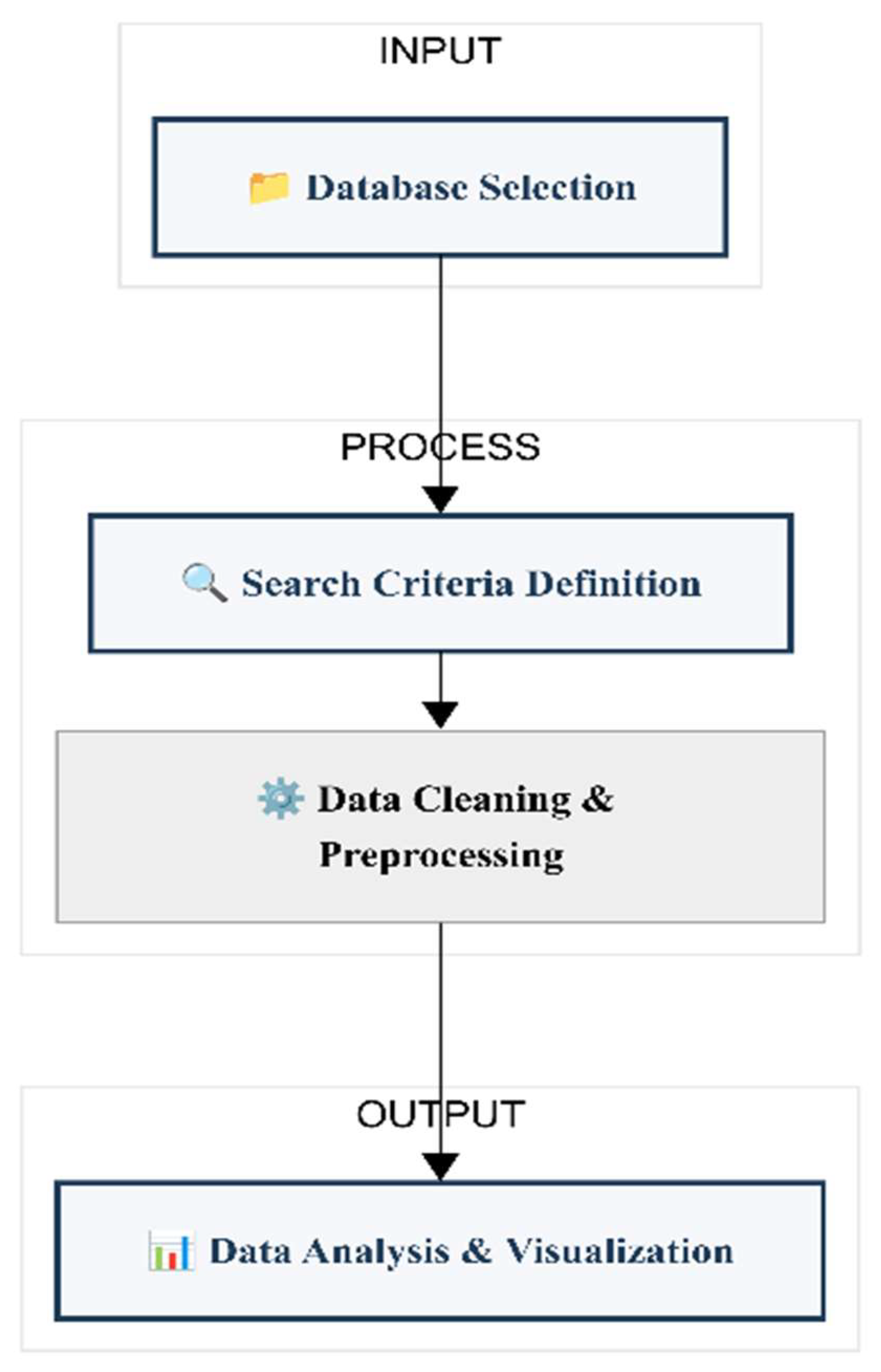
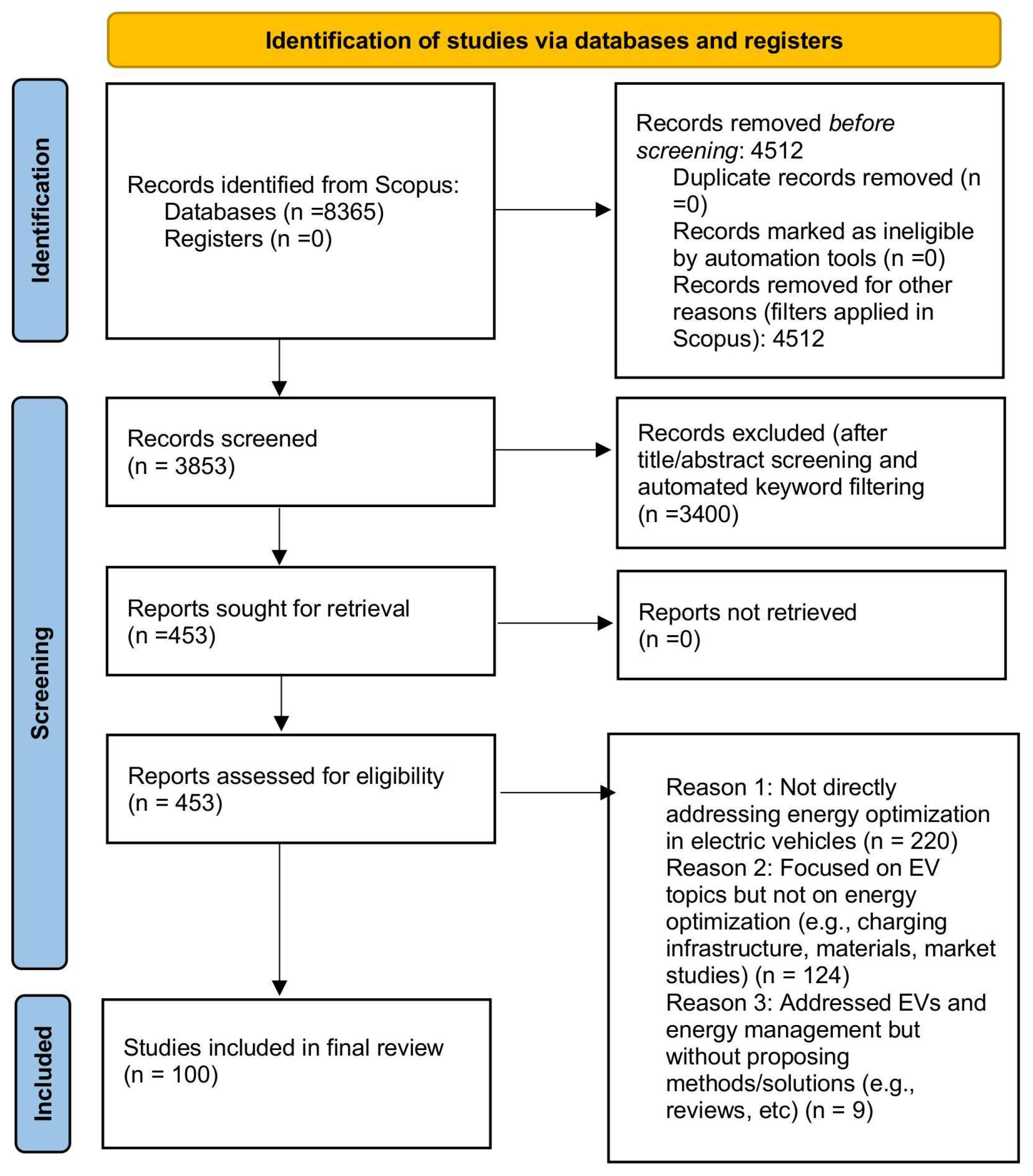
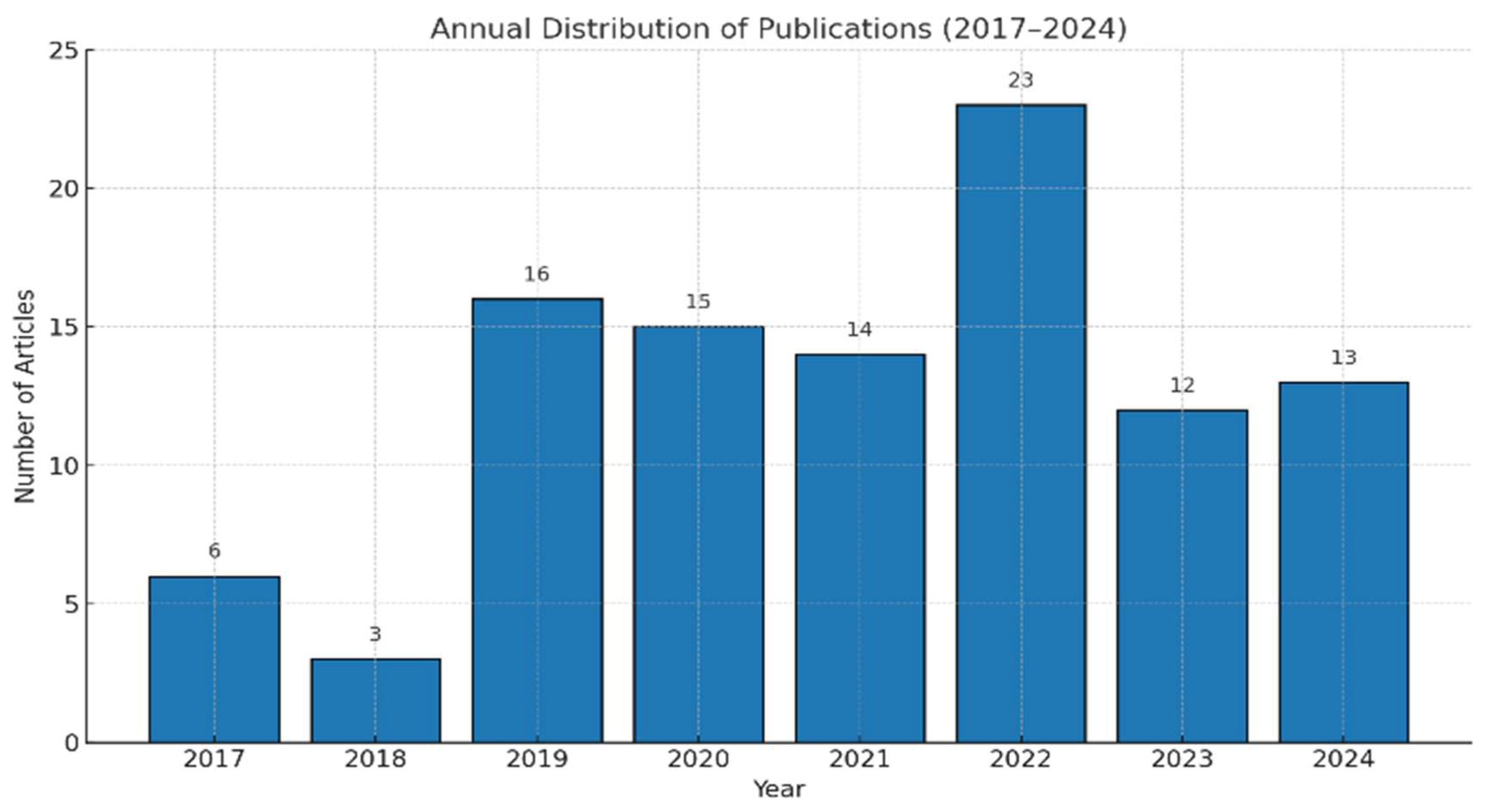
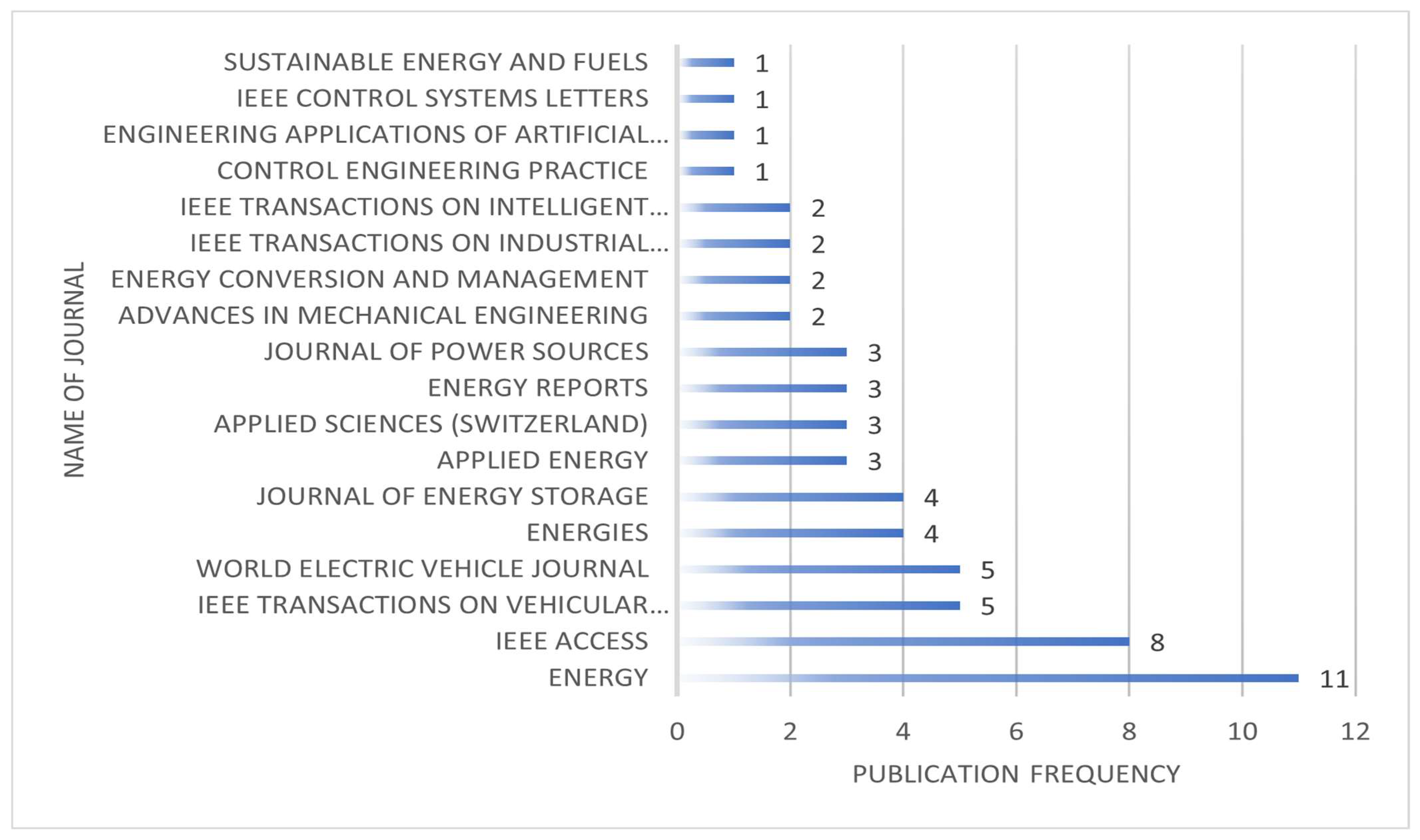
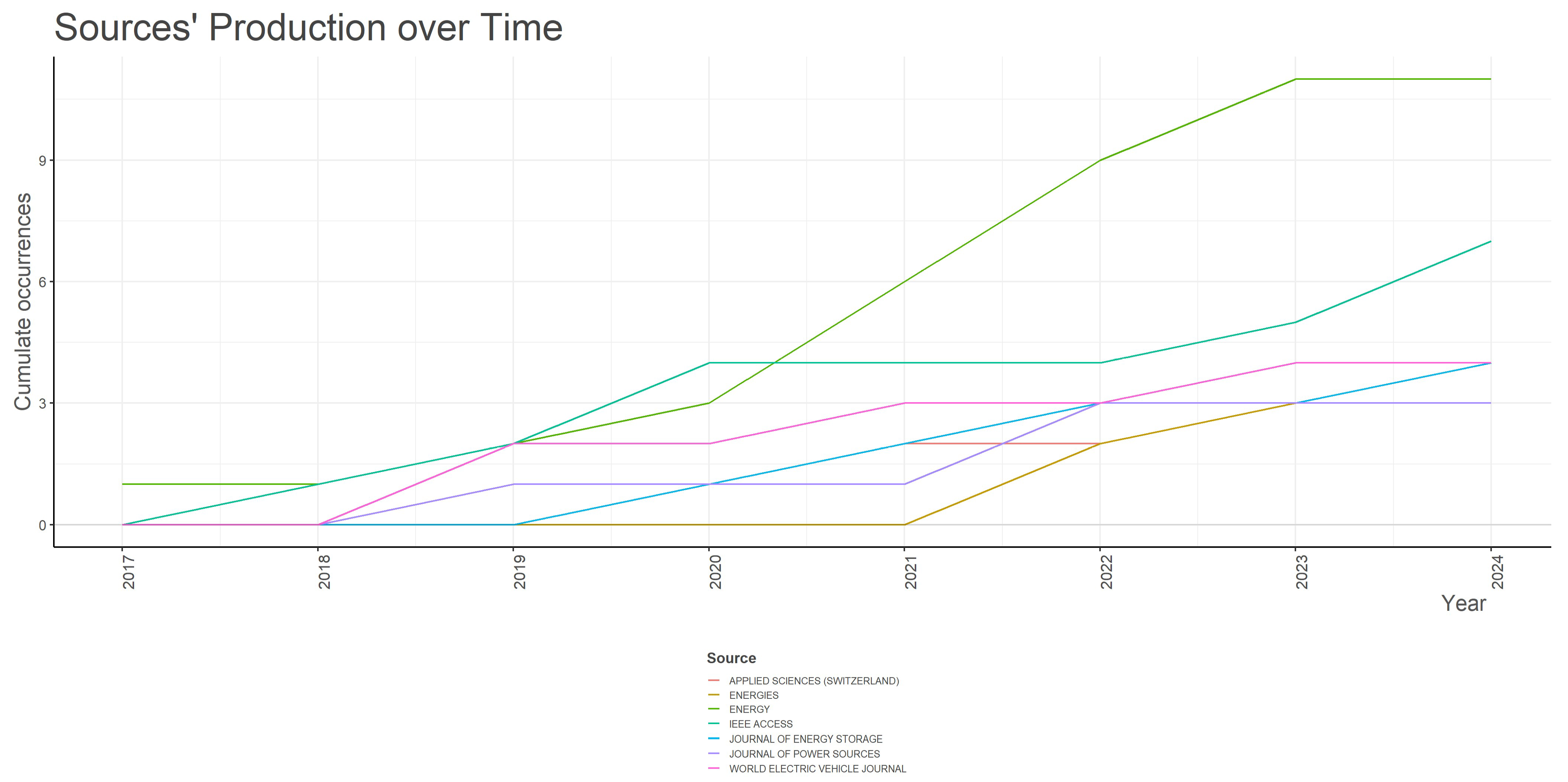
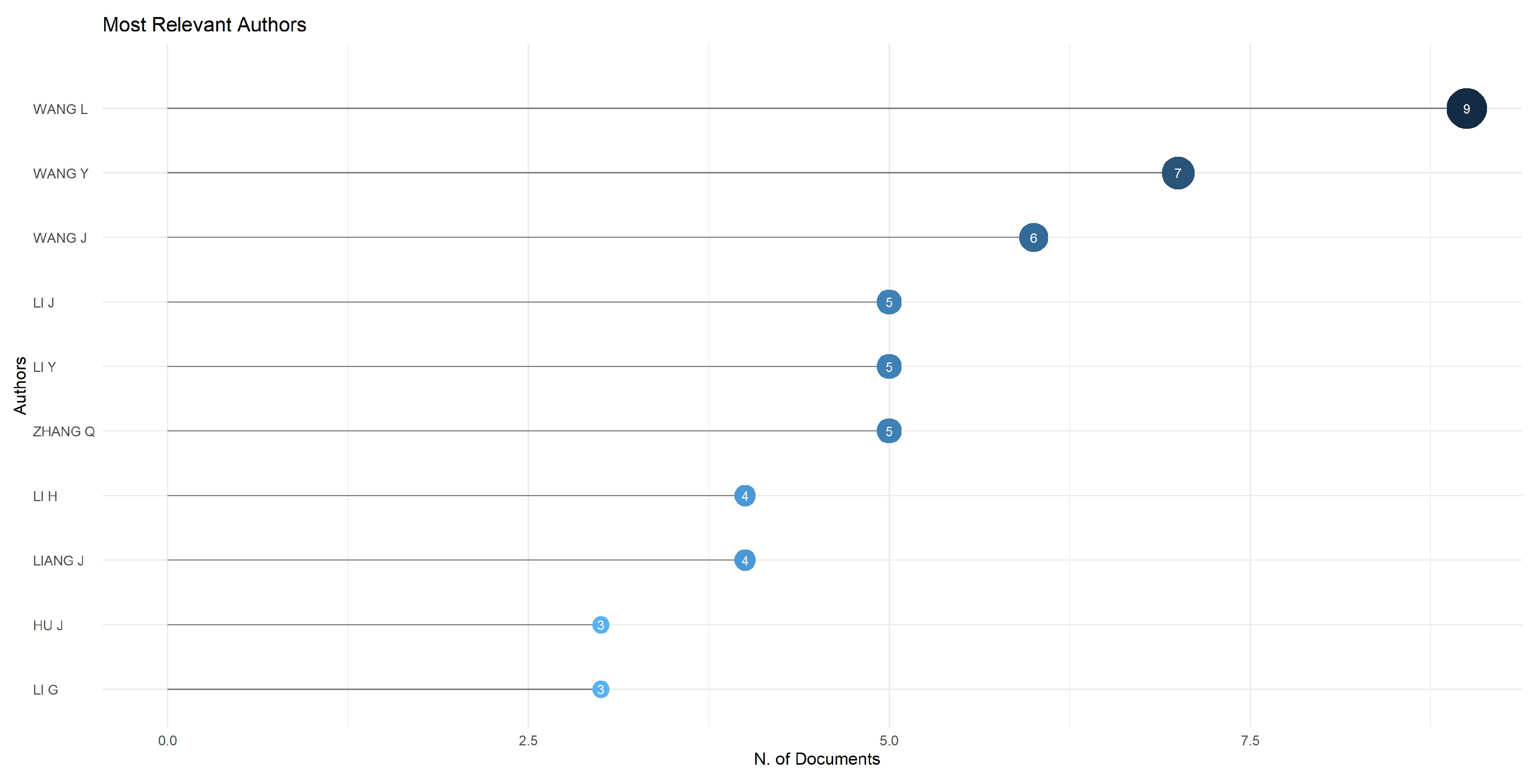
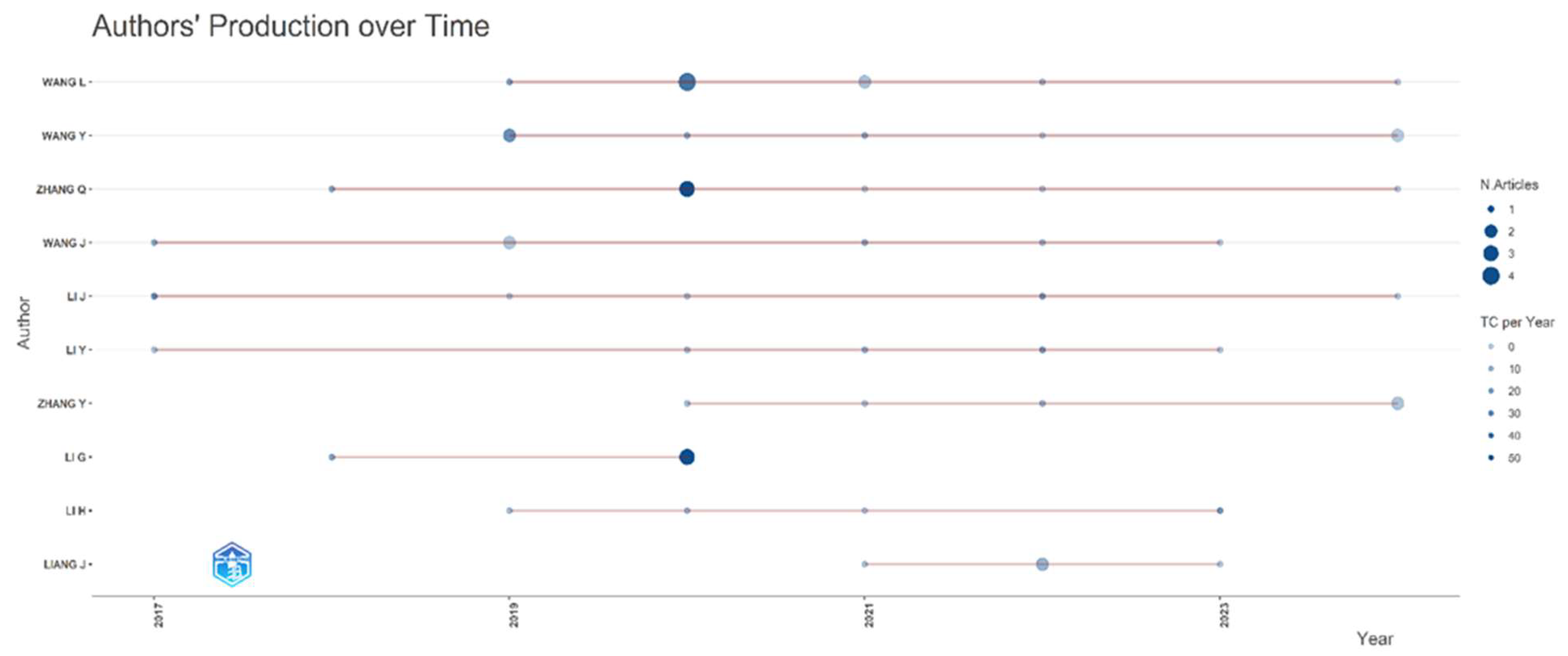
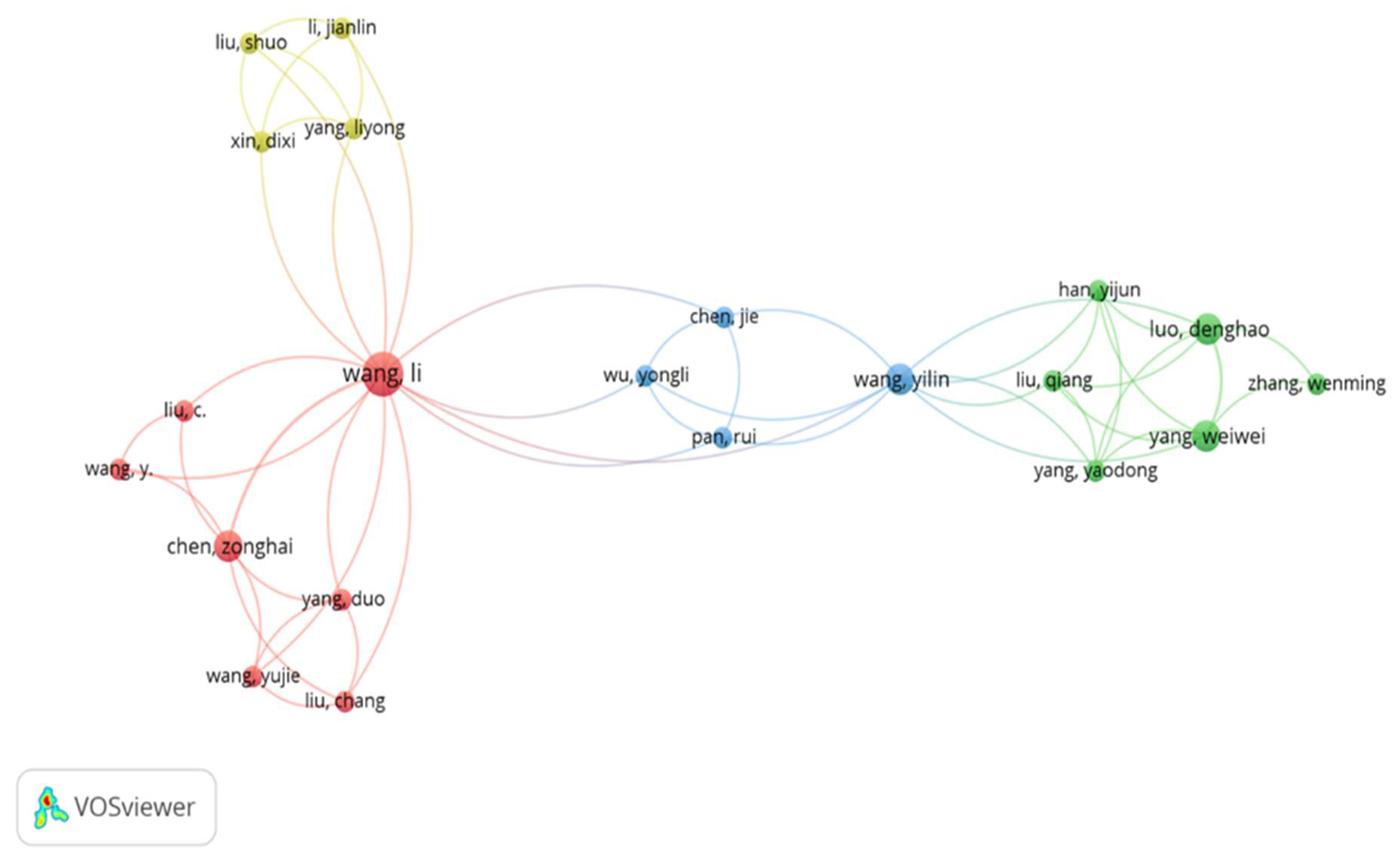
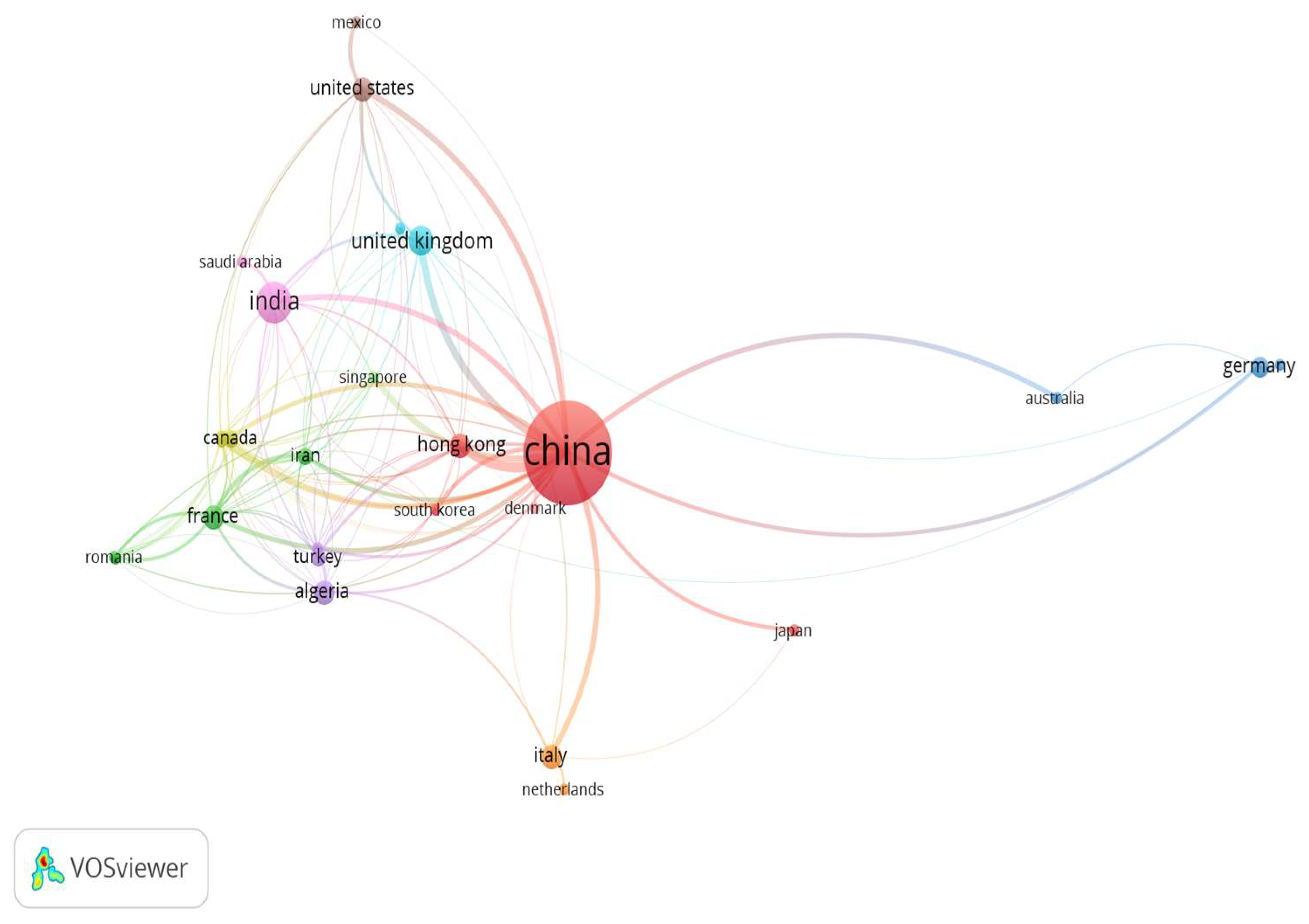
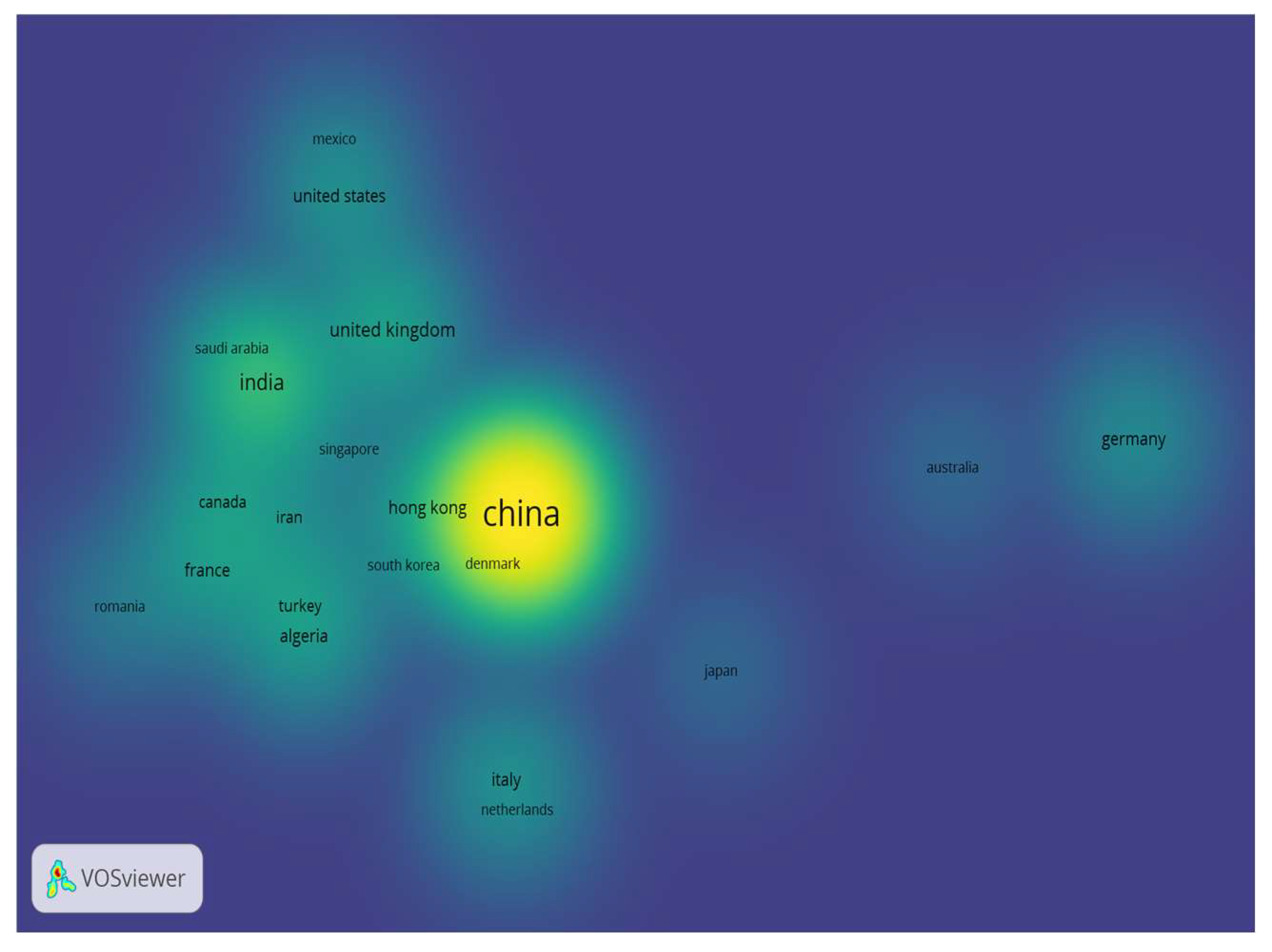
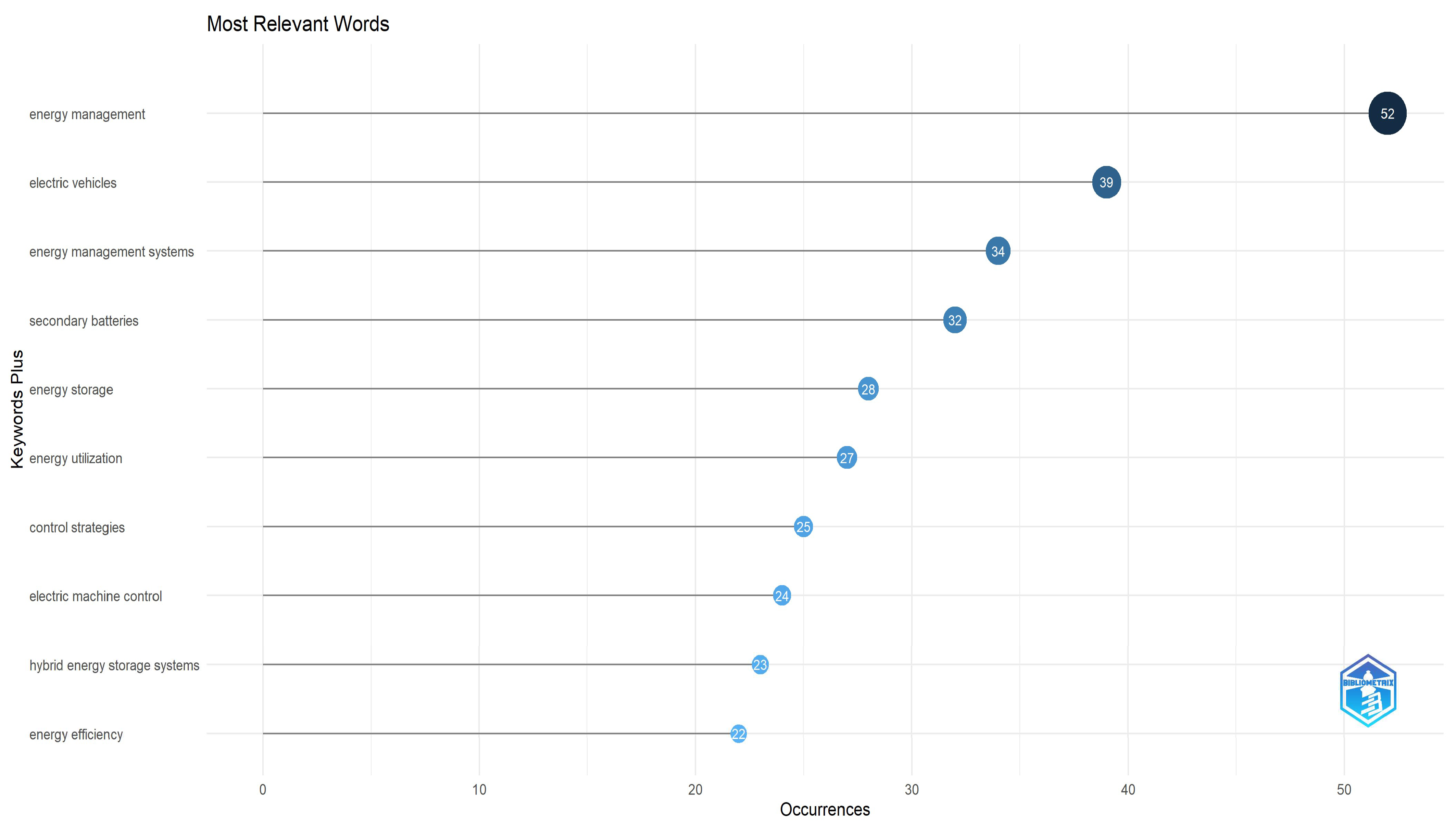
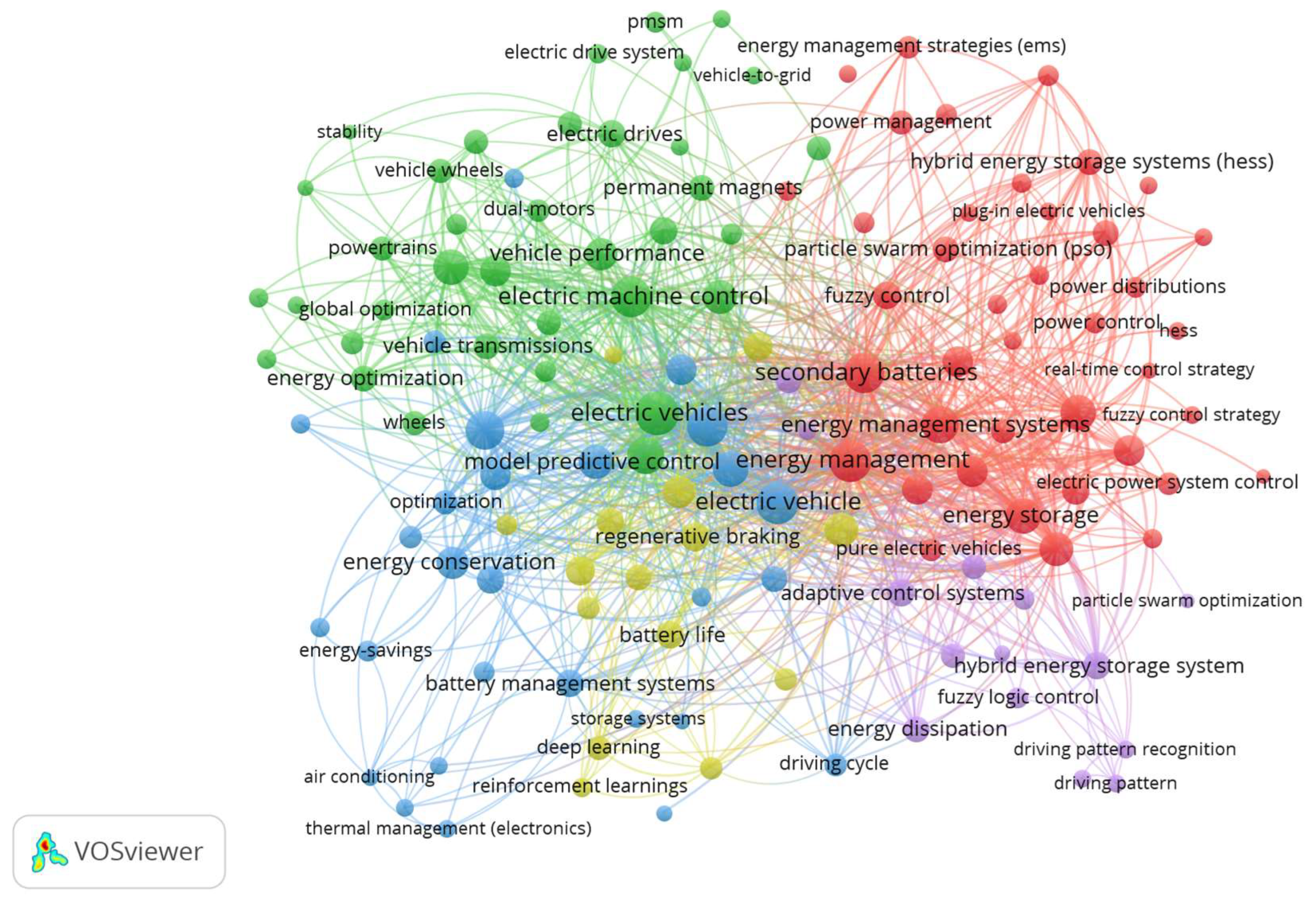
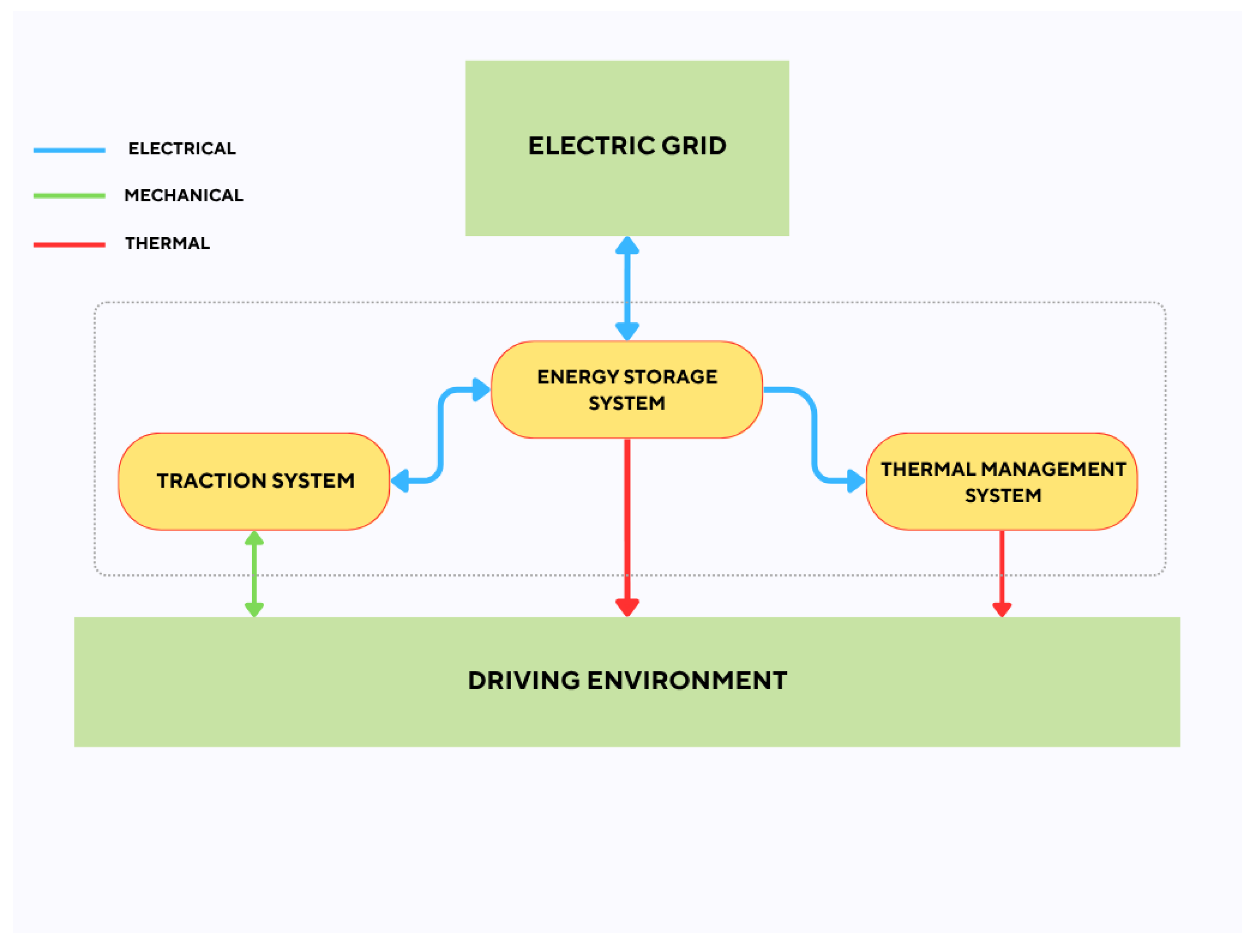
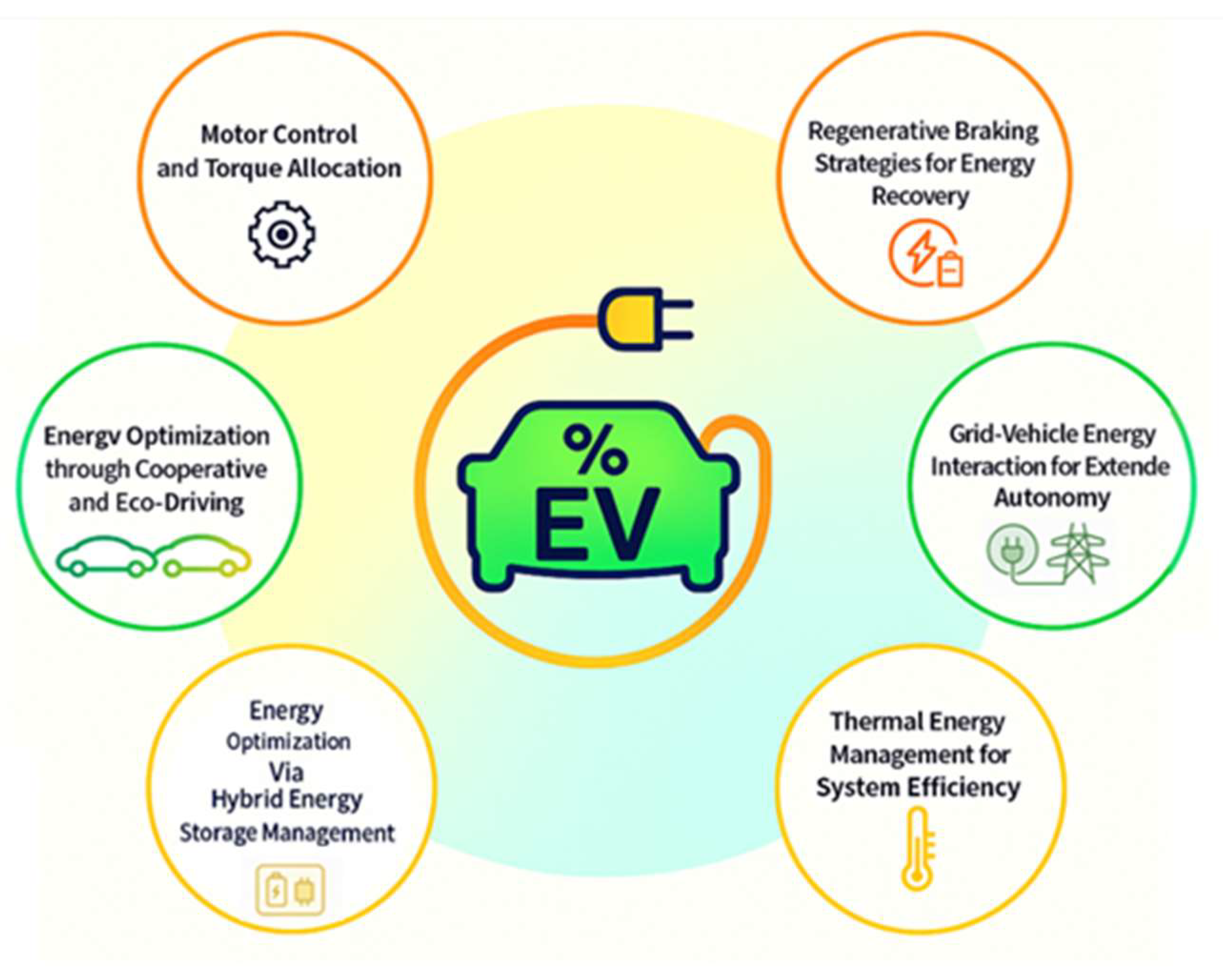
| Filtering Step | Description | Search Query/Filter | Filtered Documents |
|---|---|---|---|
| Initial identification | Retrieval of all records related to energy optimization in electric vehicles | TITLE-ABS-KEY ((“energy optimization” OR “energy consumption reduction” OR “energy management”) AND (“electric vehicle *” OR “autonomous electric vehicle *”) AND (“strategy” OR “method *” OR “algorithm *”)) | 8365 |
| Subject area filtering | Restriction to disciplines most relevant to the research | LIMIT-TO (SUBJAREA, “ENGI” OR “ENER” OR “COMP” OR “MATH” OR “ENVI”) | 8162 |
| Publication year filtering | Limitation to documents published between 2017 and 2024 to focus on recent developments | PUBYEAR > 2016 AND PUBYEAR < 2025 | 6138 |
| Document type filtering | Selection of peer-reviewed articles and literature reviews only | LIMIT-TO (DOCTYPE, “ar” OR “re”) | 3853 |
| Filtering Step | Description | Purpose |
|---|---|---|
| Duplicate removal | Identification and elimination of duplicate records using titles and DOIs | To ensure no redundancies in the dataset |
| Automated keyword filtering | Use of spreadsheet functions to detect keywords in the title, Abstract, and Keywords columns related to electric vehicles | To exclude publications not explicitly referring to electric vehicles |
| Manual check of excluded items | Quick review of documents labeled “No” to recover potentially relevant articles that used alternative wording | To avoid unintentional omission of relevant studies |
| Screening of titles and abstracts | Manual review to exclude articles not addressing energy optimization in electric vehicles | To retain only studies with direct relevance to the research objective |
| Final full-text relevance check | In-depth examination of remaining articles to confirm their scientific relevance and alignment with the research scope | To establish a final, high-quality, and coherent article set for bibliometric analysis |
| Rank | Affiliation | Articles |
|---|---|---|
| 1 | Jiangsu University | 27 |
| 2 | School of Mechanical Engineering | 19 |
| 3 | Chongqing University | 18 |
| 4 | Jilin University | 15 |
| 5 | Tsinghua University | 13 |
| 6 | Liaoning University of Technology | 12 |
| 7 | Beijing Institute of Technology | 11 |
| 8 | Central South University | 11 |
| 9 | University of Science and Technology Beijing | 10 |
| 10 | University of Science and Technology of China | 9 |
| Architecture | Main Objectives | Key Advantages | Limitations | References |
|---|---|---|---|---|
| Single-Motor | Maximize the main motor’s efficiency- Reduce electrical energy losses- Stabilize torque and dynamic response. | Simpler system structure → fewer components, lower parasitic losses Easier to model and control due to the centralized drive |
| [99,100,101,102,103,104] |
| Multi-Motor | Optimize torque distribution across multiple motors Dynamically split torque between front and rear motors Switch between mono- and dual-motor modes (Dual-Motor) Ensure dynamic stability (yaw moment, traction) Minimize global drivetrain energy losses | Allows you to make the most of the high-efficiency zones of each motor. Fine-tune the power delivered by each engine according to its instantaneous efficiency. Better management of grip, gradients, and bends thanks to differentiated engine control. Flexible mode transitions Enhanced stability and comfort thanks to precise torque modulation on each axle or wheel. |
| [80,81,105,106,107,108,109,110,111,112,113,114,115,116,117,118,119] |
| Ref. | Specific Method | Objective |
|---|---|---|
| [120] | Fuzzy Inference System (FIS) integrated into a rule-based energy management strategy. | Optimize energy recovery at urban intersections. |
| [121] | Real-time adaptive fuzzy control. | Dynamically adjust regeneration level based on battery SOC and deceleration. |
| [122] | AFSMC (Adaptive Fuzzy Sliding Mode Control). | Maximize energy recovery while regulating wheel slip. |
| [123] | Deep Reinforcement Learning: SAC and DDPG with entropy tuning. | Optimize regenerative braking under varying load and slope |
| [124] | Hybrid AI and Bio-Inspired Optimization (C4.5 LSTM Seagull Optimization Algorithm). | Adjust regeneration based on predicted route and driving behavior. |
| [125] | Deep Learning and Optimization: IDP-BLSTM (Dynamic Programming + BiLSTM). | Adapt regeneration to individual driving style. |
| [126] | A multi-objective model predictive controller (MPC). | Manage regeneration based on battery SOC and safety constraints. |
| Ref | Title | Method | Results | Constraints |
|---|---|---|---|---|
| [127] | “Implementation of an estimator-based adaptive sliding mode control strategy for a boost converter-based battery/supercapacitor hybrid energy storage system in electric vehicles,” | Adaptive SMC enriched by an estimator | Highly robust in the face of uncertainties and disturbances. Battery preservation (thanks to fine-tuned current management). System stability even under variable conditions. | Complex design (integration of adaptability and estimation). Higher computation cost in real time. Dependence on estimator quality (critical accuracy). |
| [128] | “Sliding-mode and Lyapunov function-based control for battery/supercapacitor hybrid energy storage system used in electric vehicles,” | Combined Lyapunov + Sliding Mode Control (SMC) | Stability guaranteed by the Lyapunov function. Dynamic energy sharing between the battery and SC. Efficient maintenance of DC bus voltage. | Sensitive to inaccurate models (especially for Lyapunov). Simple EMS: may not be optimal in all driving situations. |
| [129] | “H∞ Control System for Battery and Supercapacitor Hybrid Energy Storage in Electric Vehicles” | Robust H-infinity controller | Precise control of traction and regeneration current. Reduced complexity thanks to the second-order model. Optimized power sharing in both phases (traction/braking). | Simplified model: possible loss of accuracy in certain dynamic speeds. Controller is sensitive to parameter settings. No explicit adaptability to real driving conditions. |
| [130] | “Differential Flatness-Based Cascade Energy/Current Control of Battery/Supercapacitor Hybrid Source for Modern e–Vehicle Applications,” | Flatness Control (Model-based flatness control) | This strategy enables several variables (currents, DC bus energy, supercapacitor, etc.) to be controlled simultaneously. Better dynamics than conventional PI control Simplicity of control once the “flat outputs” have been identified-reduced complexity of control laws for complex systems. | Requires trajectory planning: mandatory to implement the control law. Accurate modeling is required to identify flat outputs. Not always applicable: not all systems are differentially flat. |
| [132] | “Global sliding mode control of vehicle-mounted hybrid energy storage system based on exponential reaching law” | Rule-based with a global sliding mode control strategy based on exponential reaching law (E-GSM) | Optimized distribution of energy between battery and supercapacitor. Improved robustness against disturbances, better reference tracking dynamics. (E-GSM) Guaranteed bus voltage stability. | Rule-based EMS: non-optimal and non-adaptive. E-GSM is sensitive to parameter choices and extreme conditions. |
| [133] | “Pioneering Battery-Supercapacitor Hybrid Energy Management for E-Scooters for Sustainable Urban Transportation,” | bang-bang control | Reduced stress The battery extends its life improve overall system efficiency | Simple but not adaptive |
| [83] | “Optimal Control Strategy to Maximize the Performance of Hybrid Energy Storage System for Electric Vehicle Considering Topography Information,” | Adaptive fuzzy control with CPS (contour positioning system) integrated into rule-based EMS | Intelligent power distribution according to the slope of the terrain, for greater energy efficiency and reduced stress on the battery. | Dependence on slope measurement accuracy; complexity of implementing adaptive controllers in real-life conditions. |
| [134] | “Composite Non-Linear Control of Hybrid Energy-Storage System in Electric Vehicle,” | a rule-based energy management strategy | Good robustness against system uncertainties. Precise tracking of current references. Optimum power distribution between sources (battery/SC). Stable DC bus voltage. Allows efficient optimization of EV power under variable conditions. | Complexity of implementation (combination of several nonlinear methods). Depends on model quality for exact linearization. |
| [136] | “Adaptive power allocation strategy for hybrid energy storage system based on Hilbert-Huang transform,” | Fuzzy control with frequency analysis | Dynamic frequency adaptation of energy flow Reduced battery stress | Complex tuning, possible latency |
| [137] | “Vehicle Speed Optimized Fuzzy Energy Management for Hybrid Energy Storage System in Electric Vehicles,” | Speed-based fuzzy control (VSO-FEMS: vehicle speed optimized fuzzy energy management strategy) | Energy saving and longer battery life reduces total energy consumption by 1.28% compared to a conventional fuzzy control strategy | Strong dependency on speed prediction |
| [138] | “Research on vehicle controller and control strategy for pure electric vehicle with composite power,” | fuzzy logic | intelligent, flexible management of energy flows according to driving scenario Reduces the complexity of control based solely on rigid equations. Easy to adapt to new cases with only added rules. | Requires good tuning |
| [139] | “Multi-Fuzzy Control Based Energy Management Strategy of Battery/Super-capacitor Hybrid Energy System of Electric Vehicles.” | Fuzzy control | Peak reduction Battery protection Improved stability and efficiency | Complexity implementation multi-controller |
| [140] | “Research on Energy Management Strategy of Battery-Flywheel Hybrid Energy Storage Electric Vehicle,” | Fuzzy control | Lower battery stress, inertia-based energy support | complex mechanical integration |
| [141] | “Implementation of a predictive energy management strategy for battery and supercapacitor hybrid energy storage systems of pure electric vehicles,” | Markov chain-based power demand prediction with fuzzy logic control. | Current peak reduction Stable current flow | Rigid filtering, limited flexibility |
| [142] | “A Power Distribution Strategy for Hybrid Energy Storage System Using Adaptive Model Predictive Control,” | AMPC Adaptive MPC | More effective in terms of system efficiency and battery conservation, as the peak battery cell current can be reduced by at least 24.4% and the total energy loss by at least 6.4% with the proportional integral (PI) and model predictive control methods. Battery amp-hour output and root-mean-square battery current can be reduced by 16.2% and 29.8%, respectively. | Design complexity High computational load Sensitivity to the quality of the adaptive model: errors in adaptation can degrade performance. |
| [143] | “A Predictive Set-Point Modulation Energy Management Strategy for Hybrid Energy Storage Systems,” | Predictive Modulation (predictive setpoint modulation) | better use of the supercapacitors, reducing the load on the battery. Protects battery life. Reduced voltage fluctuations on the DC bus, ensuring stable operation. Long-term sustainable power supply thanks to adaptive power allocation. | Complexity of implementation Dependence on the system model and increased computational load Difficulty of optimization under variable conditions |
| [144] | “A predictive power management scheme for a hybrid energy storage system in an electric vehicle,” | Modified MPC (Simplified MPC for DC bus voltage) | Stable bus regulation Reduced computation | Simplified model |
| [145] | “Linear Parameter-Varying Model Predictive Control for Intelligent Energy Management in Battery/Supercapacitor Electric Vehicles,” | LPV-MPC (Linear Parameter Varying MPC) | Dynamic energy distribution Accurate and predictive | Model uncertainty sensitivity |
| [146] | “Load-adaptive real-time energy management strategy for battery/ultracapacitor hybrid energy storage system using dynamic programming optimization,” | dynamic programming optimization DP | reduces battery wear and tear (reduction in total current from 3.4% to 15.7%) and energy losses (reduction from 3% to 15.1%), compared with a conventional per-rule strategy | Non-adaptive rules are fixed after offline training |
| [147] | “Multi-objective benchmark for energy management of dual-source electric vehicles: An optimal control approach,” | alt-PMP (alternative Pontryagin’s Minimum Principle | minimizing battery degradation and SC subsystem losses. | Choice of critical weighting coefficients: incorrect settings can unbalance objectives. Less robust than AI methods in the face of unmodelled uncertainties or unforeseen driving variations. |
| [148] | “A significant energy management control strategy for a hybrid source EV,” | (Particle Swarm Optimization—PSO) | Efficiently finds the best way to share power between the battery and the supercapacitor, to improve the vehicle’s range and performance while preserving battery life. | Not adaptive in real-time |
| [149] | “Combined Sizing & Energy Management of Hess for An Electric Vehicle by PSO With Novel Power Sharing Control Strategy” | Particle Swarm Optimization (PSO) | Reduced consumption | Lack of dynamic flexibility Complex multi-goal setting |
| [84] | “Optimization and control of battery-flywheel compound energy storage system during an electric vehicle braking,” | Genetic algorithm | Intelligent distribution of energy between the two sources, depending on driving conditions 42.27% reduction in maximum battery charging current compared with a single battery system, reducing wear and improving service life. Improved stability and robustness of the flywheel system | Computationally intensive genetic algorithm The need for a precise model |
| [150] | “Multi-objective optimization-based real-time control strategy for battery/ultracapacitor hybrid energy management systems,” | Multi-objective optimization solved using the Karush-Kuhn-Tucker | Reduces energy loss and battery stress. Extends battery life by limiting overcharging. Improves overall hybrid system performance thanks to better coordination between the two sources. | Requires fine calibration of weights Dependence on precise models |
| [151] | “A soft actor-critic-based energy management strategy for electric vehicles with hybrid energy storage systems,” | Soft Actor Critic RL | The results of this research indicate that SAC-based EMS reduces HESS energy loss by 8.75% and 6.09% compared to Deep Q Network (DQN)- and Deep Deterministic Policy Gradient (DDPG)-based EMS, respectively. Stable and efficient thanks to offline learning Less sensitive to hyperparameters Performs complex continuous-action tasks | More computationally expensive as it uses multiple networks May converge slowly due to continuous exploration |
| [82] | “Energy management of an electric vehicle by a hybrid energy storage system with novel control strategy,” | neural networks (ANN) | SOC optimization and Voltage stability | Requires prior training |
| [152] | “Stochastic Control of Predictive Power Management for Battery/Supercapacitor Hybrid Energy Storage Systems of Electric Vehicles,” | neural networks (ANN) | Efficient anticipation of energy demand Reduced battery wear through frequency separation Adaptation to driving profiles | Requires training data for a neural network Sensitivity to prediction errors Complex implementation (combining prediction + optimization) |
| [153] | “Hierarchical Q-learning network for online simultaneous optimization of energy efficiency and battery life of the battery/ultracapacitor electric vehicle,” | Q-learning (Hierarchical tabular Q-learning) | Battery capacity conservation increased vehicle range Adaptation over time | Requires extensive training |
| [154] | “Intelligent Energy Management for Full-Active Hybrid Energy Storage Systems in Electric Vehicles Using Teaching-Learning-Based Optimization in Fuzzy Logic Algorithms,” | Teaching–Learning-Based Optimization with Fuzzy Logic | Energy reduction peak smoothing | Difficulty integrating into real-time environments |
| [157] | “Energy Management Control Strategy for Hybrid Energy Storage Systems in Electric Vehicles,” | Multilayer hybrid fuzzy (Fuzzy; Markov; Wavelet) | Adaptive energy allocation by dynamics Dynamic adaptation to demand | Difficult to tune, complex structure |
| [155] | “Optimization of Hybrid Energy Storage System Control Strategy for Pure Electric Vehicle Based on Typical Driving Cycle,” | fuzzy control strategy enhanced with GA | With GA, reducing energy consumption by 3 to 9% compared with the PSO, depending on the scenarios simulated. | Complex to tune |
| [158] | A real-time energy management control strategy for battery and supercapacitor hybrid energy storage systems of pure electric vehicles | Wavelet Transform (offline), Neural Network (trained to emulate wavelet decomposition), and Fuzzy Logic Controller | 18% reduction in battery ageing costs compared with the conventional filtration-based control strategy Effective suppression of power peaks and reduction in battery current variations. | Need for offline pre-processing (neural network training from wavelet decomposition). Sensitivity to training quality. Combined hardware implementation complexity (neural network + fuzzy logic). |
| [159] | “Fuzzy Predictive Energy Management for Hybrid Energy Storage Systems of Pure Electric Vehicles using Markov Chain Model,” | Prediction-based fuzzy control (Fuzzy and Markov) | Smart energy allocation prediction Intelligent responsiveness | Sensitive to prediction uncertainty |
| [160] | “Optimal energy management for a Li-ion battery/supercapacitor hybrid energy storage system based on a particle swarm optimization incorporating Nelder-Mead simplex approach,” | Fuzzy and PSO/Nelder-Mead | Reduces stress on the battery, resulting in up to 20% longer battery life than a battery-only solution. Maintains good performance in terms of power output. | Algorithmic complexity (PSO and NM are non-trivial algorithms). Difficult to implement in real time without simplification or acceleration. Initial tuning required |
| [161] | “A regulatory power split strategy for energy management with battery and ultracapacitor,” | PI-regulated fuzzy control | Current peak suppression in HESS Good power distribution | Non-implementation specified on real cycles |
| [162] | “Spatial–temporal data-driven full driving cycle prediction for optimal energy management of battery/supercapacitor electric vehicles,” | LSTM-based velocity prediction and spatio-temporal interpolation (STIM) and multi-horizon MPC (MH-MPC) | Vision on several time scales: combines short and long horizons Anticipates changes in route, speed, or constraints, improving overall energy efficiency | Increased algorithmic complexity Need for reliable models over all horizons |
| [87] | “Optimal power-split of hybrid energy storage system using Pontryagin’s minimum principle and deep reinforcement learning approach for electric vehicle application,” | PMP with deep reinforcement learning (RL) | Minimize energy consumption and battery degradation Reduce aging and energy loss | High computation cost |
| [163] | “A new adaptive PSO-PID control strategy of hybrid energy storage system for electric vehicles,” | PSO-tuned PID | Significant improvement in performance compared to a conventional PID. Global optimization of energy management via PSO. Simple implementation with good stability and reduced energy consumption. | Offline approach: the PSO optimization phase is carried out offline, so there is no ability to adapt in real time. Less robust than advanced non-linear strategies (SMC, fuzzy, etc.) under highly variable or uncertain conditions. |
| [164] | “Fuzzy-Super Twisting control implementation of battery/super capacitor for electric vehicles,” | Fuzzy logic-based EMS and Super-Twisting Sliding Mode Control (ST-SMC) | Improved source longevity and system autonomy Smooth power distribution with dynamic adaptation to driving cycles Accurate DC-bus and SC voltage regulation Power frequency filtering: steady-state handled by battery, transients by SC Robust speed tracking with low torque/flux ripples | Rule-based EMS may need expert tuning for robustness in diverse real conditions Experimental validation limited to a small-scale prototype Integration of fuzzy logic with second-order SMC requires careful stability analysis |
| [156] | “Performance Analysis of MPBC with PI and Fuzzy Logic Controllers Applied to Solar Powered Electric Vehicle Application,” | Hybrid controller: MPBC (Measurement of Parameter-Based Controller) combined with fuzzy logic (FLC) and proportional-integral (PI) controllers, forming two different hybrid controllers named MPBC+FLC and MPBC+PI | Smooth transition between battery and supercapacitor based on motor speed and current. Improved power management under variable conditions. | Requires accurate real-time motor data (speed, current). Complexity due to the hybrid control structure. Dependence on the tuning of both MPBC and FLC/PI components. |
| Article | Type of Cooperative Driving | Control Method | Optimized Parameters | Energy Optimization Strategy | Reported Energy Savings |
|---|---|---|---|---|---|
| [171] | Eco-Car-Following | Model Predictive Control (MPC) | Follower vehicle speed | Incorporation of power demand as a key term in the cost function | The proposed Economy-Oriented Car-Following Control (EOCFC) strategy achieved improvements in energy efficiency of 0.53%, 3.33%, and 1.51% under NEDC, UDDS, and WLTC driving cycles, respectively, compared to a standard multi-objective adaptive cruise control method |
| [85] | Eco-Car-Following | MPC combined with NARX prediction and variable weighting | Motor torque, vehicle speed, inter-vehicle distance | Minimization of motor energy consumption and mitigation of battery current peaks | Demonstrated superior efficiency and smoother torque control than classical MPC, LQR, PID, and dynamic programming under NEDC and WVUCITY conditions |
| [172] | Platooning with front- and rear-independent drive vehicles | Multi-objective Nonlinear MPC | Longitudinal control and torque distribution between axles | Optimization of total power consumption across the vehicle platoon | Reported overall platoon energy savings of 3.0%, 1.6%, and 4.7% under UDDS, WLTC, and HWFET test conditions, respectively |
| [173] | Platooning with constraint handling and energy-aware leader control | Distributed Reference Governor (RG) with Nonlinear MPC for the leader | String stability, leader energy consumption | Energy-efficient leader trajectory planning with RG constraint enforcement | Improved total energy economy of the platoon (exact gains not numerically specified), validated via HIL testing |
| [174] | Platooning with regenerative braking | Distributed MPC with brake force distribution strategy | Vehicle speed, trajectory, braking force | Optimized recovery of braking energy within regulatory safety limits | Improvement in energy efficiency validated through simulation and hardware-in-the-loop testing |
| [175] | Platooning with hybrid energy storage (HESS) | Distributed MPC (upper layer) and Rolling Horizon optimization (lower layer) | Speed profiles of each vehicle, battery, and supercapacitor energy allocation | Joint optimization of cooperative speed planning and real-time energy distribution in HESS systems | Exact numerical gain not specified, though effectiveness demonstrated through simulation results |
| [176] | Predictive platooning with terrain preview and V2V communication | Nonlinear MPC with terrain and leader motion prediction | Speed and motor torque | Anticipatory control using slope and leader trajectory forecasts to reduce energy demand. | Achieved superior efficiency compared to strategies without prediction, though quantitative gains were not explicitly provided |
| [86] | Cooperative eco-driving at intersections | Genetic Algorithm for offline speed planning and Sliding Mode Control for tracking | Predefined speed trajectory | Energy savings through smoothed speed transitions and V2X-based coordination | Up to 26% reduction in energy consumption compared to the rule-based Intelligent Driver Model (IDM) and Adaptive Cruise Control (ACC) in cooperative scenarios |
Disclaimer/Publisher’s Note: The statements, opinions and data contained in all publications are solely those of the individual author(s) and contributor(s) and not of MDPI and/or the editor(s). MDPI and/or the editor(s) disclaim responsibility for any injury to people or property resulting from any ideas, methods, instructions or products referred to in the content. |
© 2025 by the authors. Published by MDPI on behalf of the World Electric Vehicle Association. Licensee MDPI, Basel, Switzerland. This article is an open access article distributed under the terms and conditions of the Creative Commons Attribution (CC BY) license (https://creativecommons.org/licenses/by/4.0/).
Share and Cite
Tarout, H.; Zaki, H.; Chahbouni, A.; Ennajih, E.; Louragli, E.M. Optimizing Energy Consumption in Electric Vehicles: A Systematic and Bibliometric Review of Recent Advances. World Electr. Veh. J. 2025, 16, 577. https://doi.org/10.3390/wevj16100577
Tarout H, Zaki H, Chahbouni A, Ennajih E, Louragli EM. Optimizing Energy Consumption in Electric Vehicles: A Systematic and Bibliometric Review of Recent Advances. World Electric Vehicle Journal. 2025; 16(10):577. https://doi.org/10.3390/wevj16100577
Chicago/Turabian StyleTarout, Hind, Hanane Zaki, Amine Chahbouni, Elmehdi Ennajih, and El Mustapha Louragli. 2025. "Optimizing Energy Consumption in Electric Vehicles: A Systematic and Bibliometric Review of Recent Advances" World Electric Vehicle Journal 16, no. 10: 577. https://doi.org/10.3390/wevj16100577
APA StyleTarout, H., Zaki, H., Chahbouni, A., Ennajih, E., & Louragli, E. M. (2025). Optimizing Energy Consumption in Electric Vehicles: A Systematic and Bibliometric Review of Recent Advances. World Electric Vehicle Journal, 16(10), 577. https://doi.org/10.3390/wevj16100577







